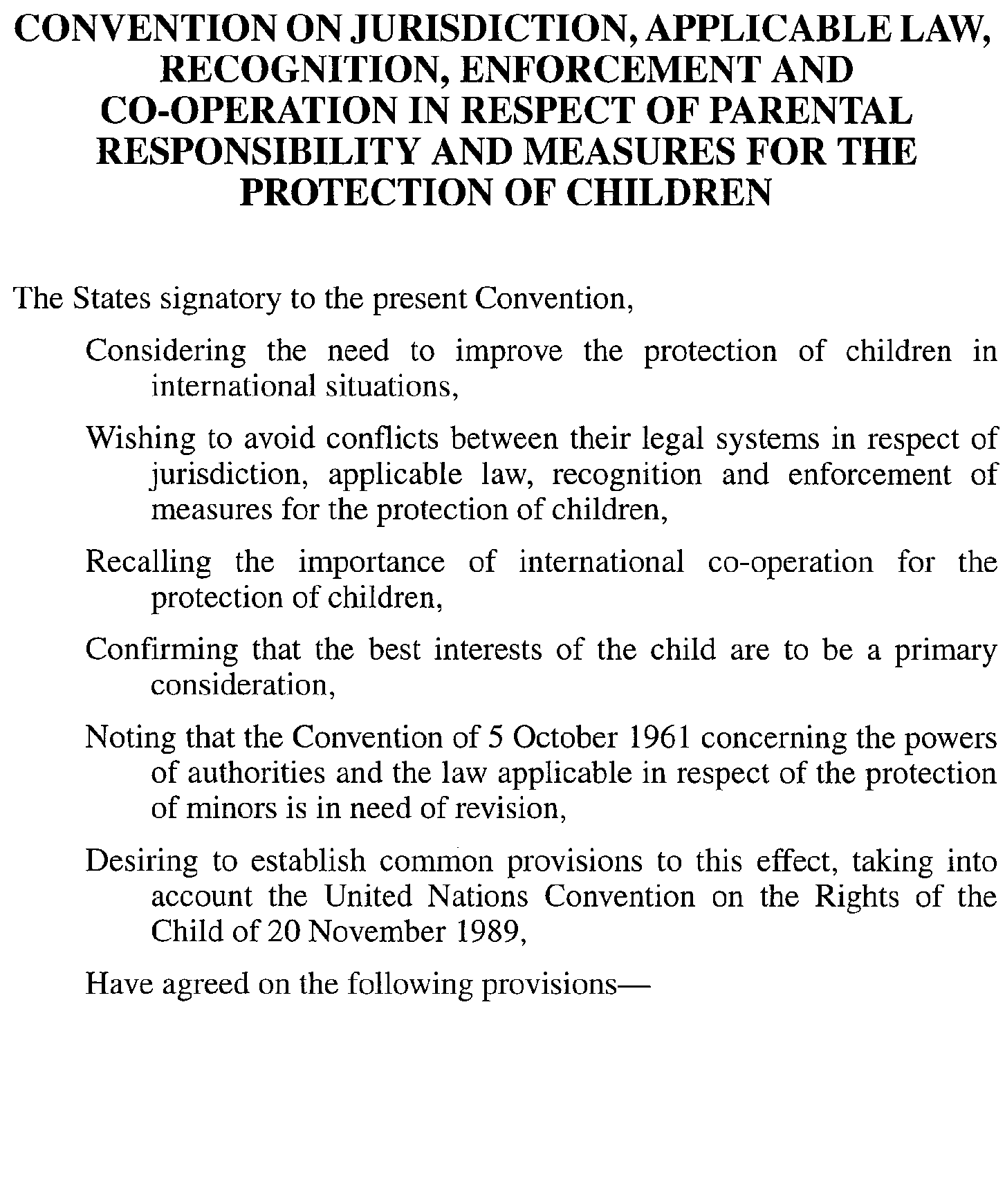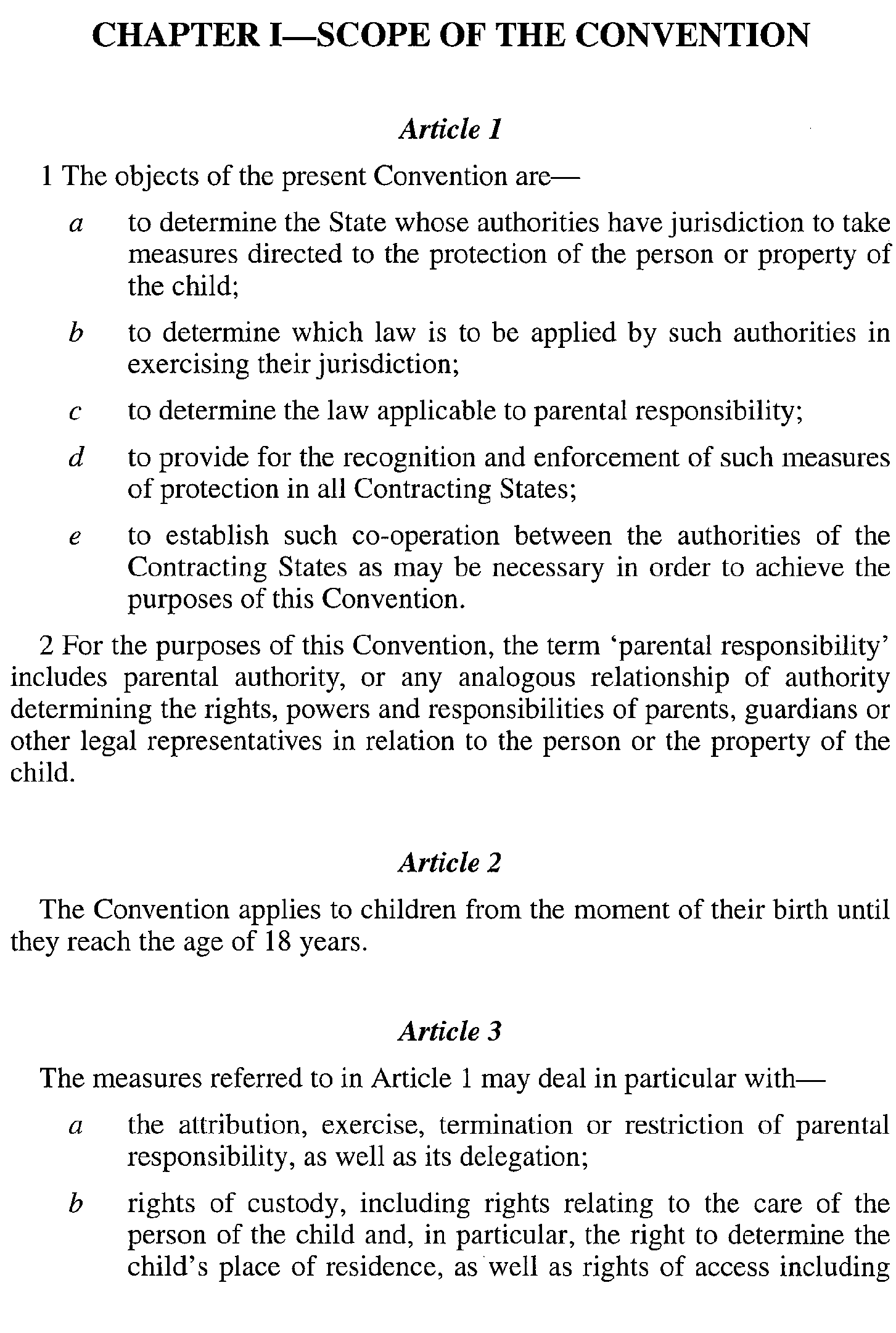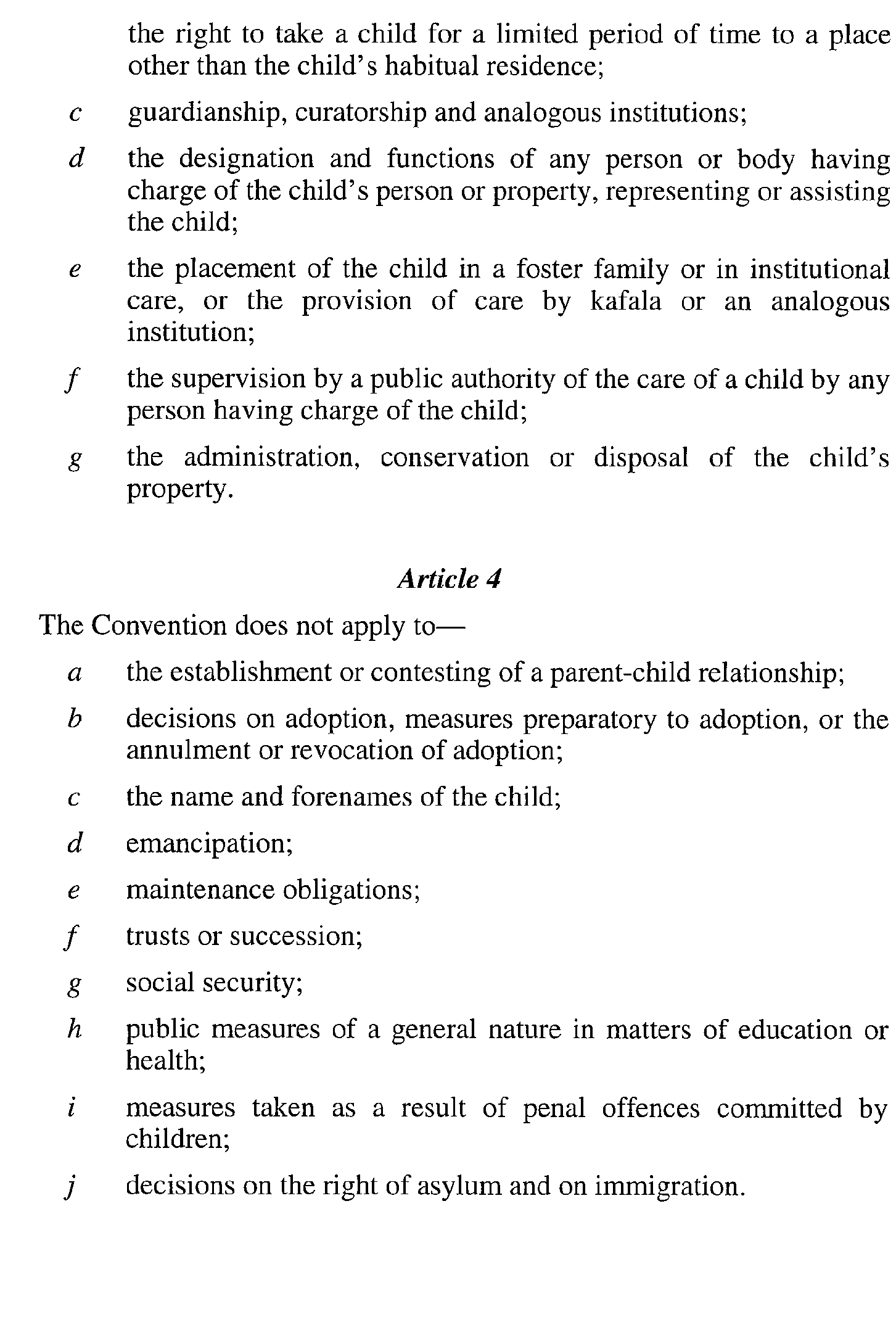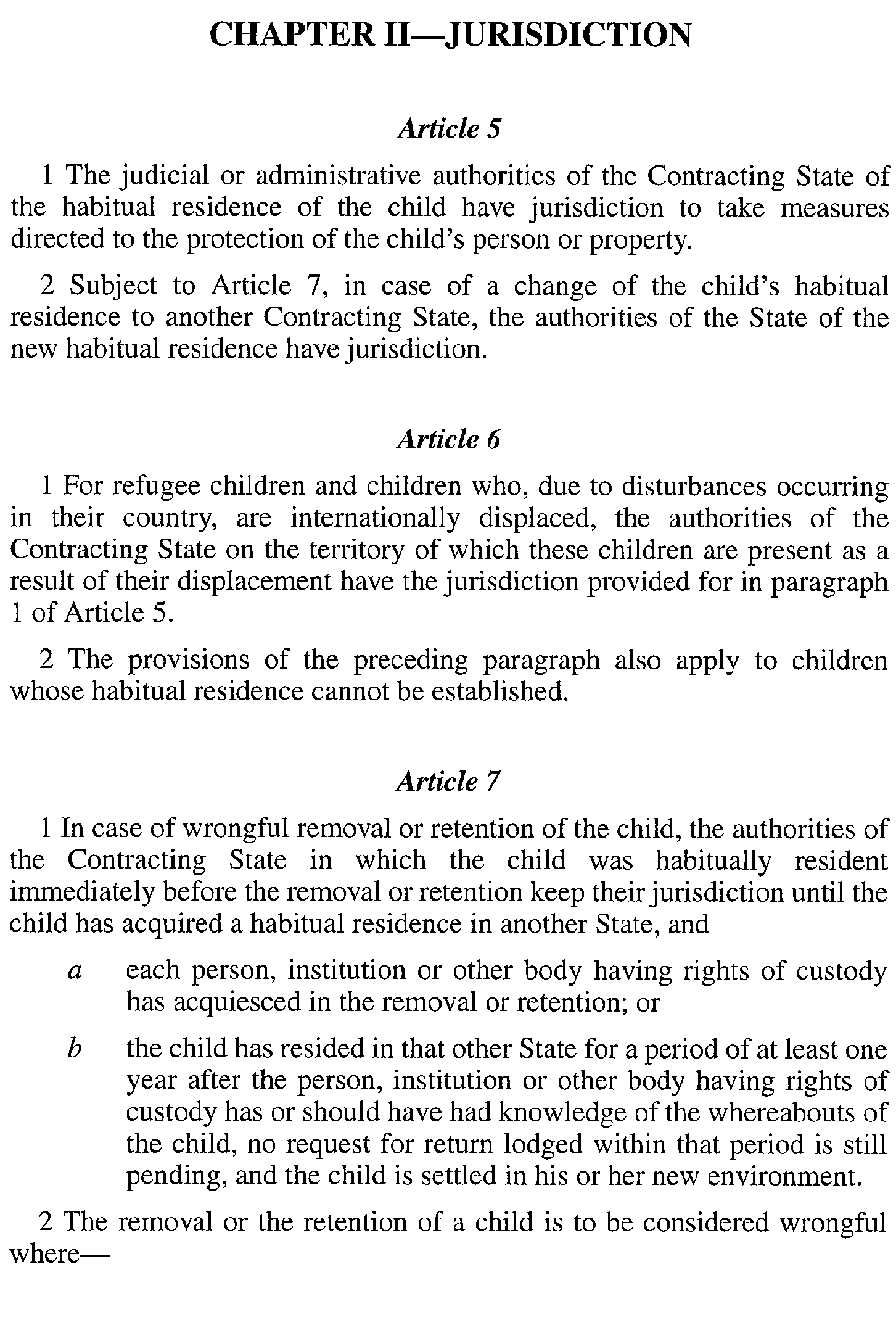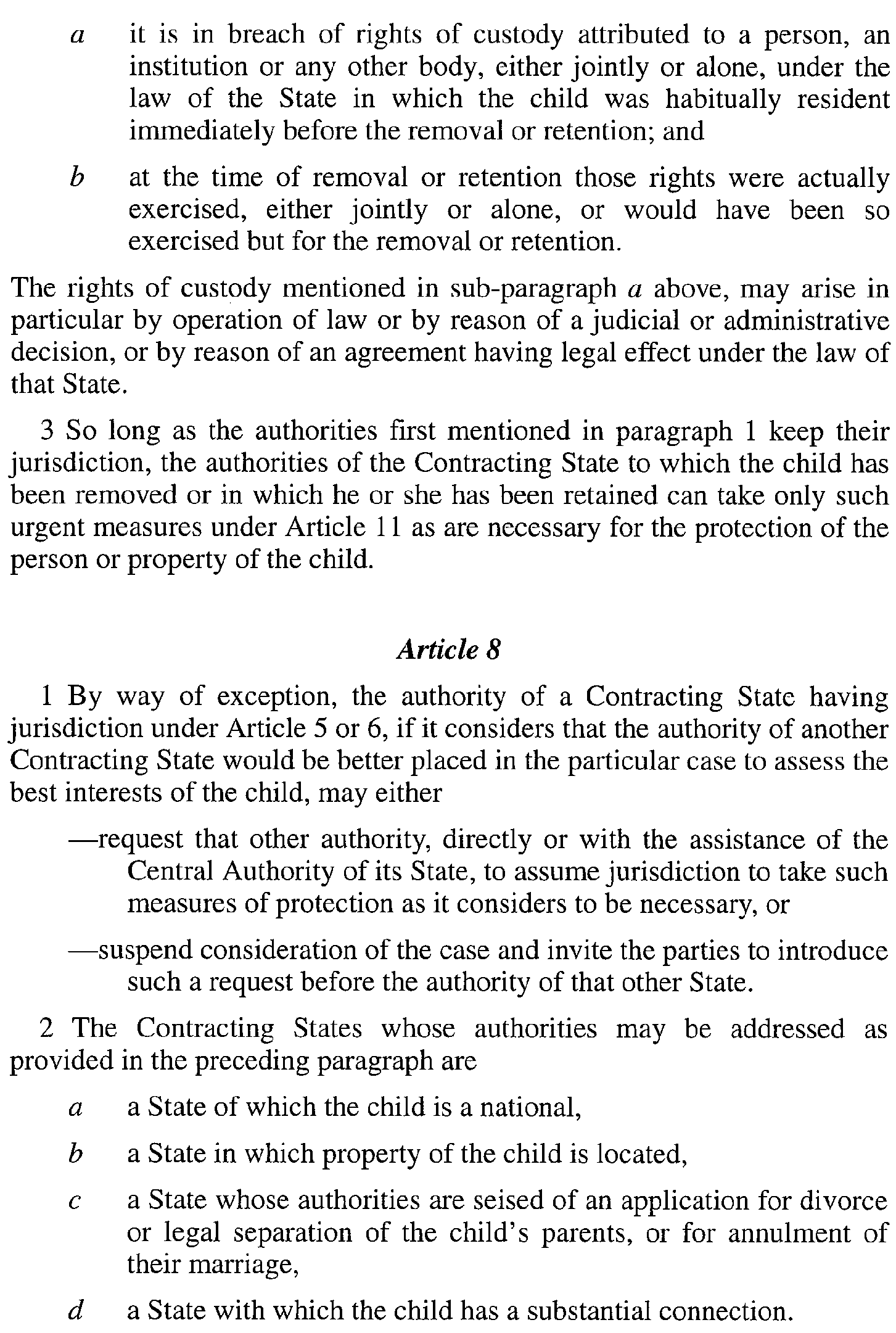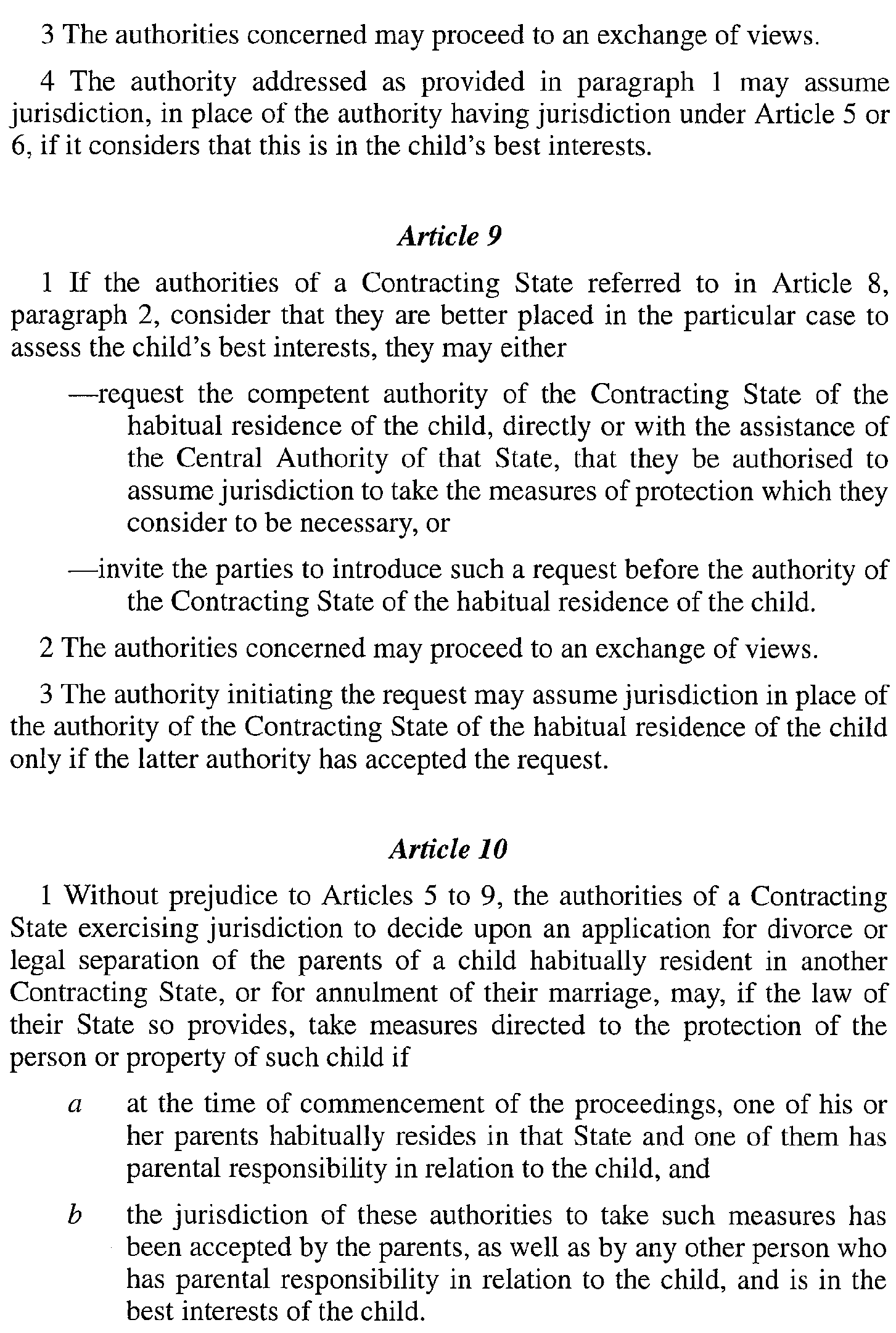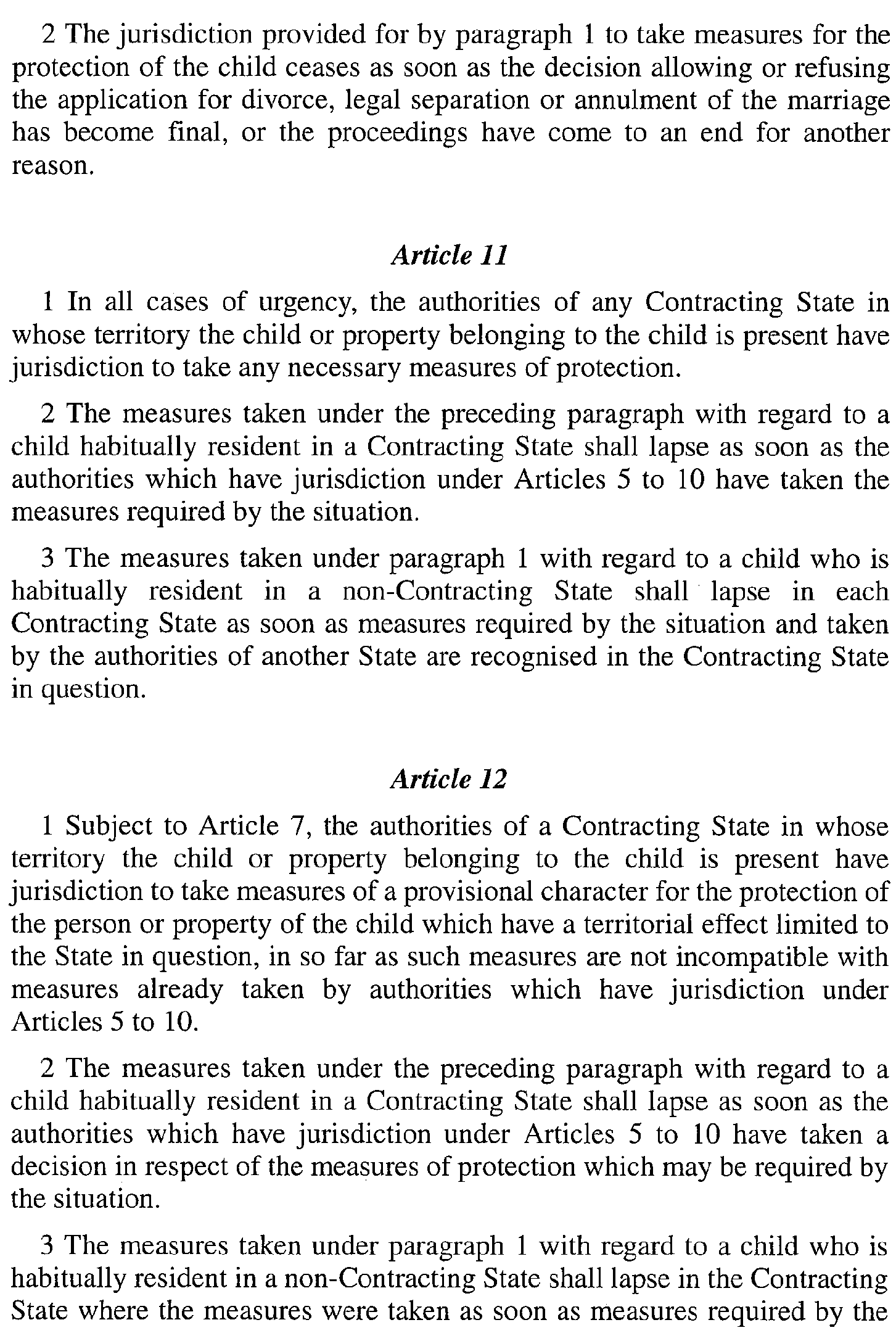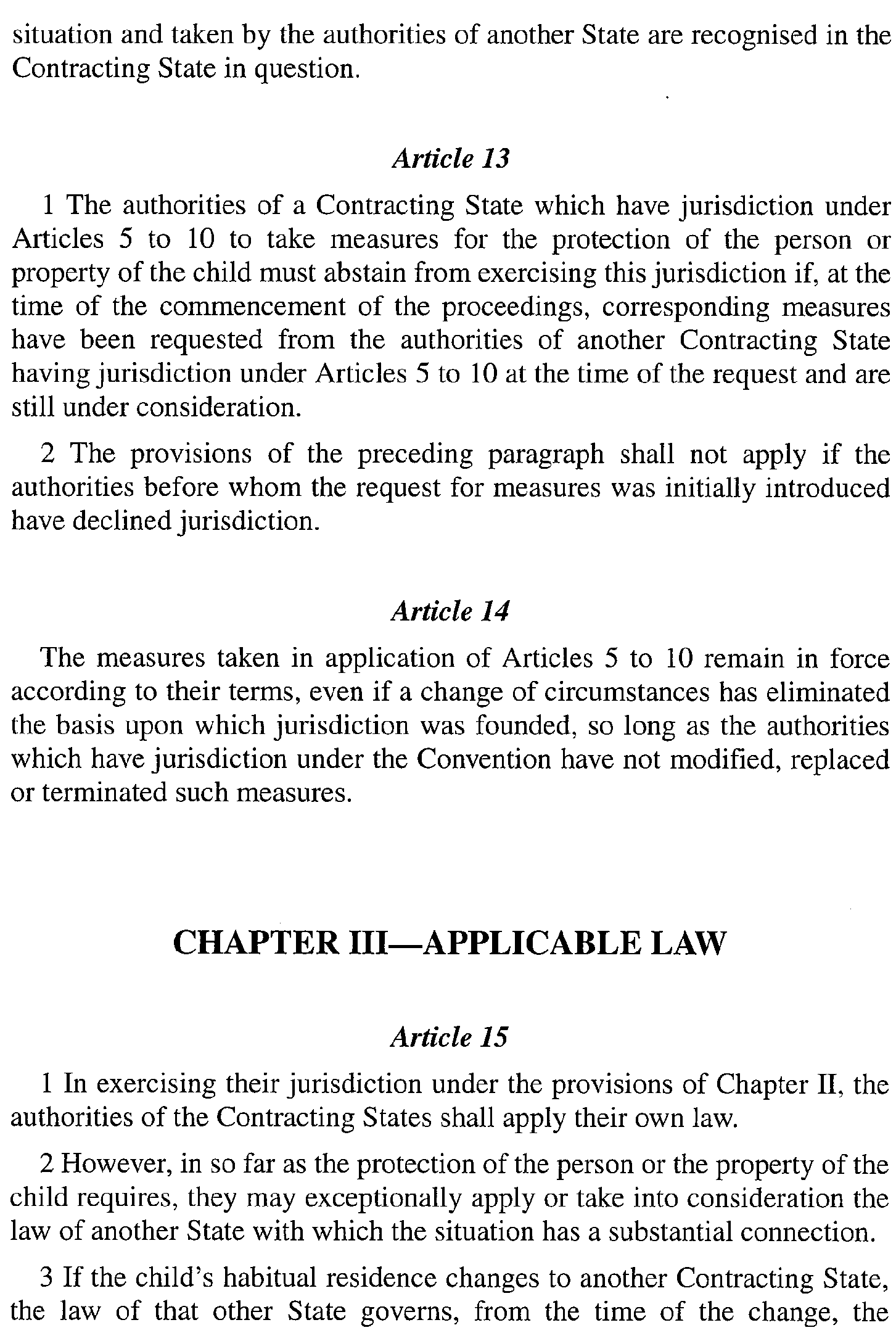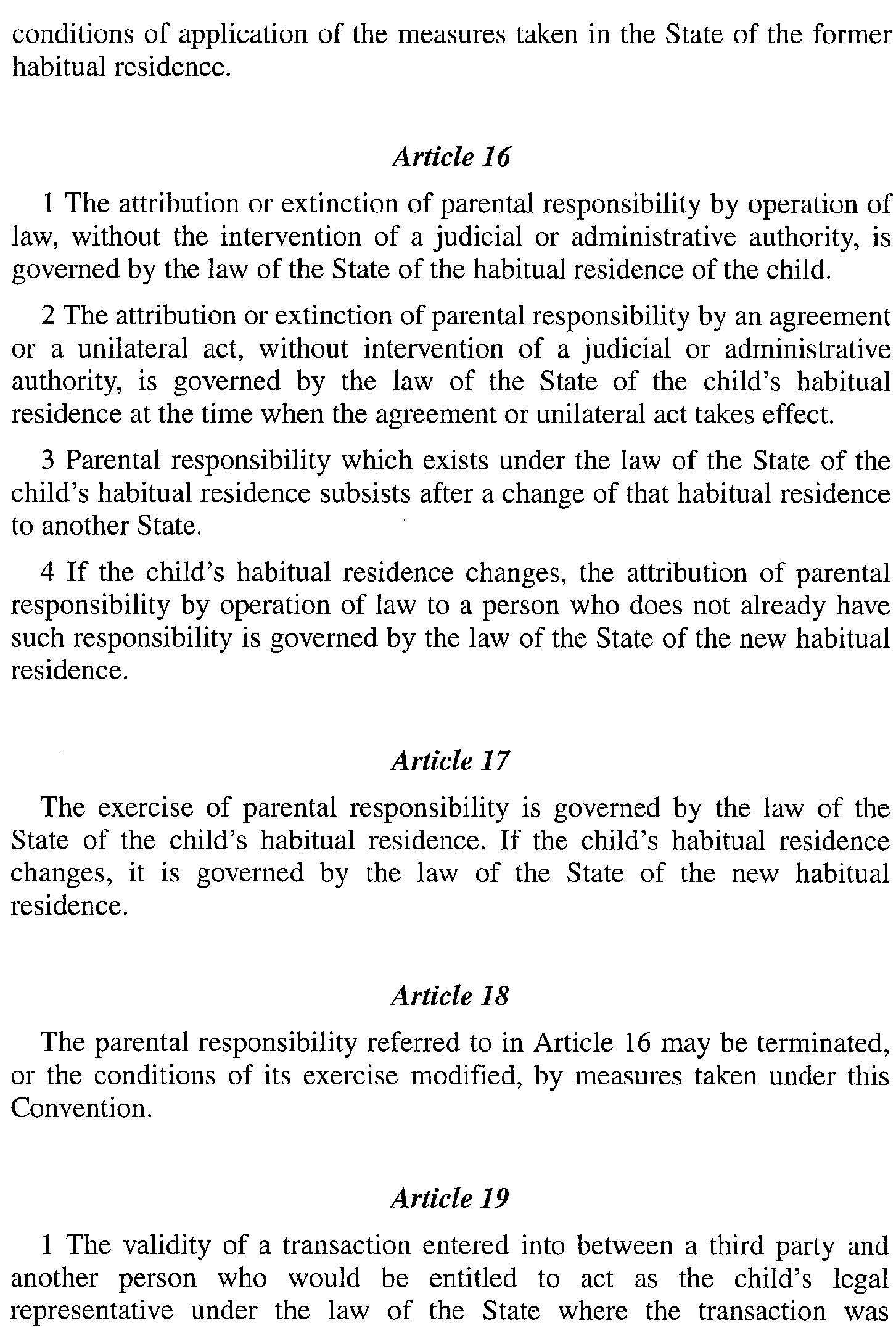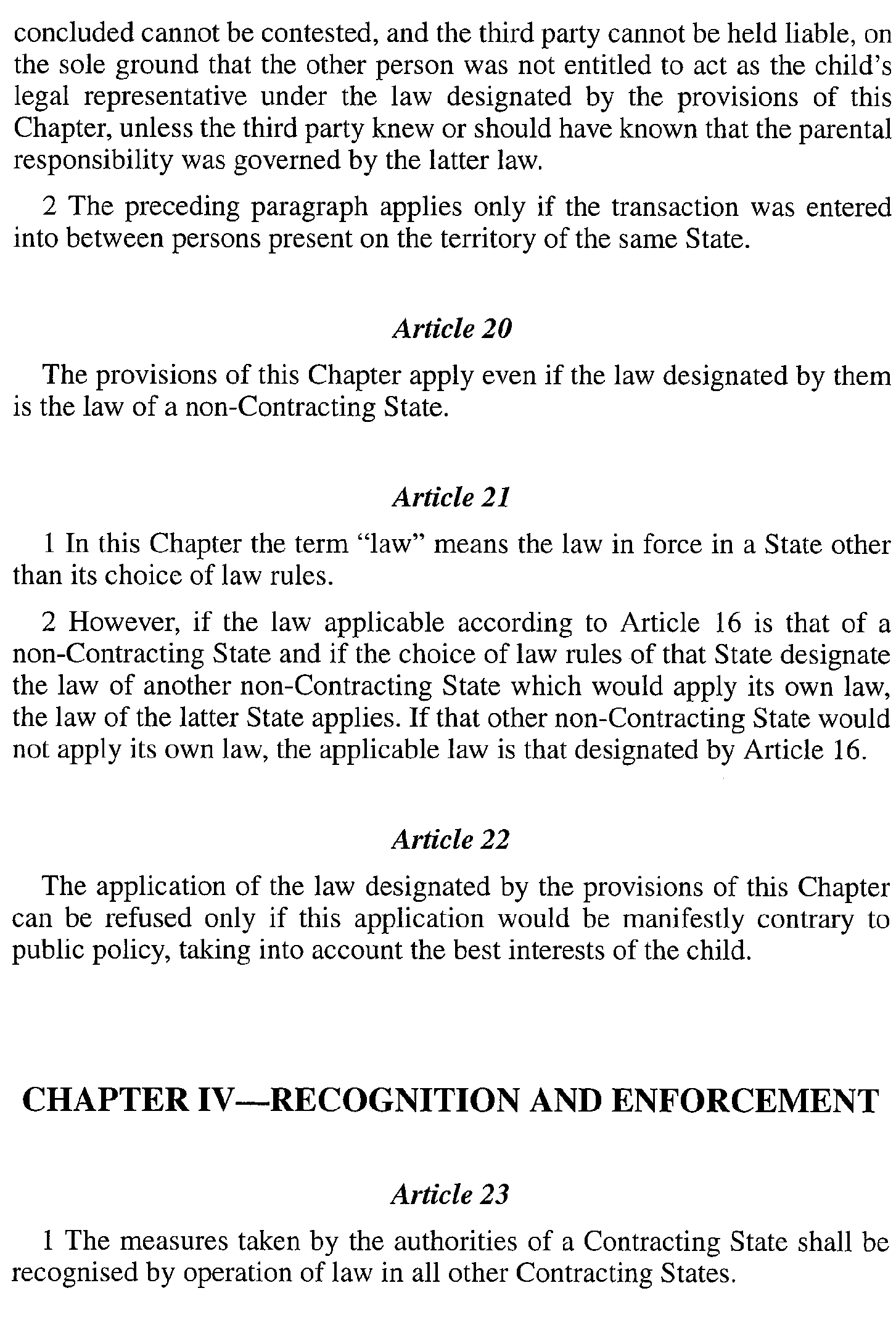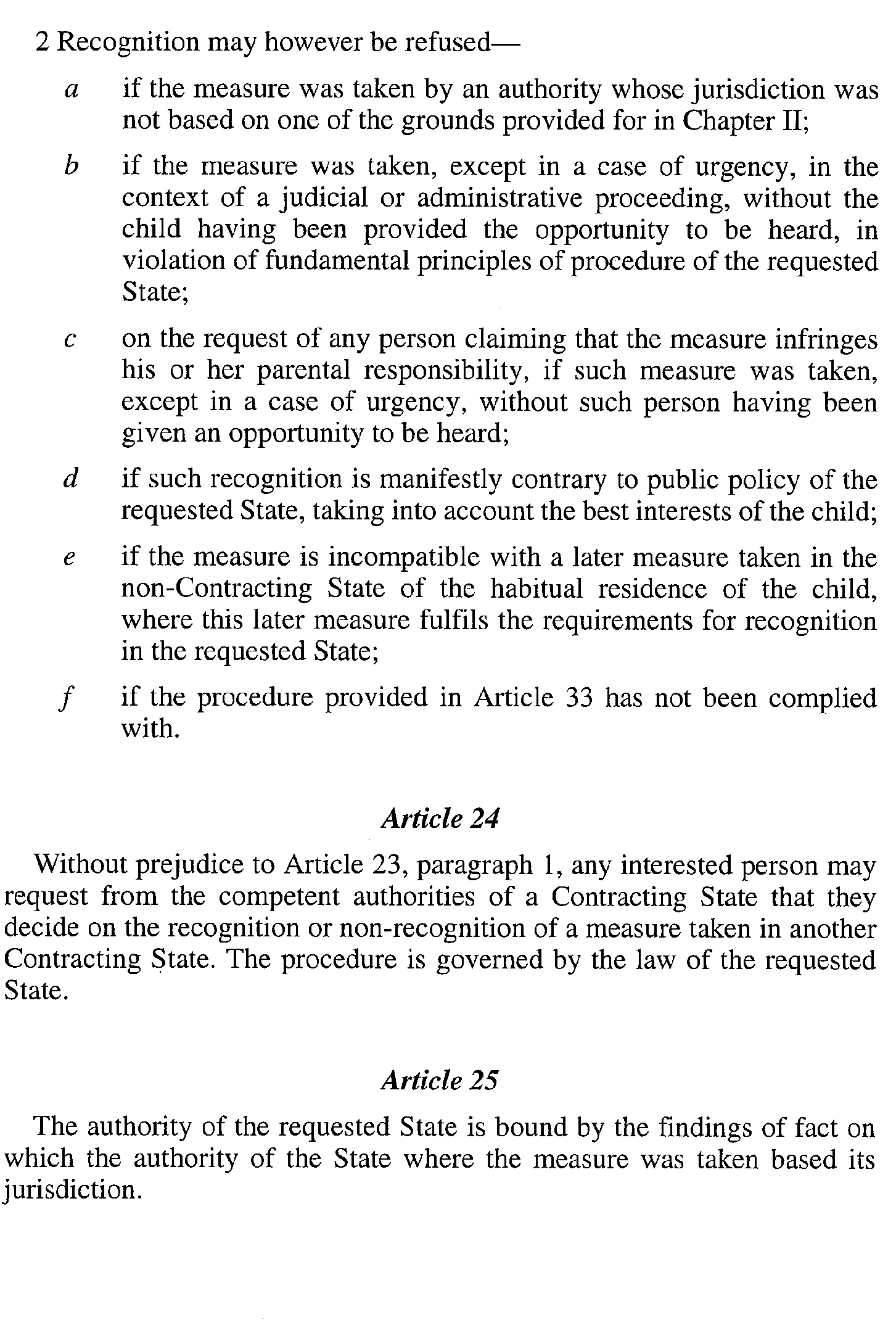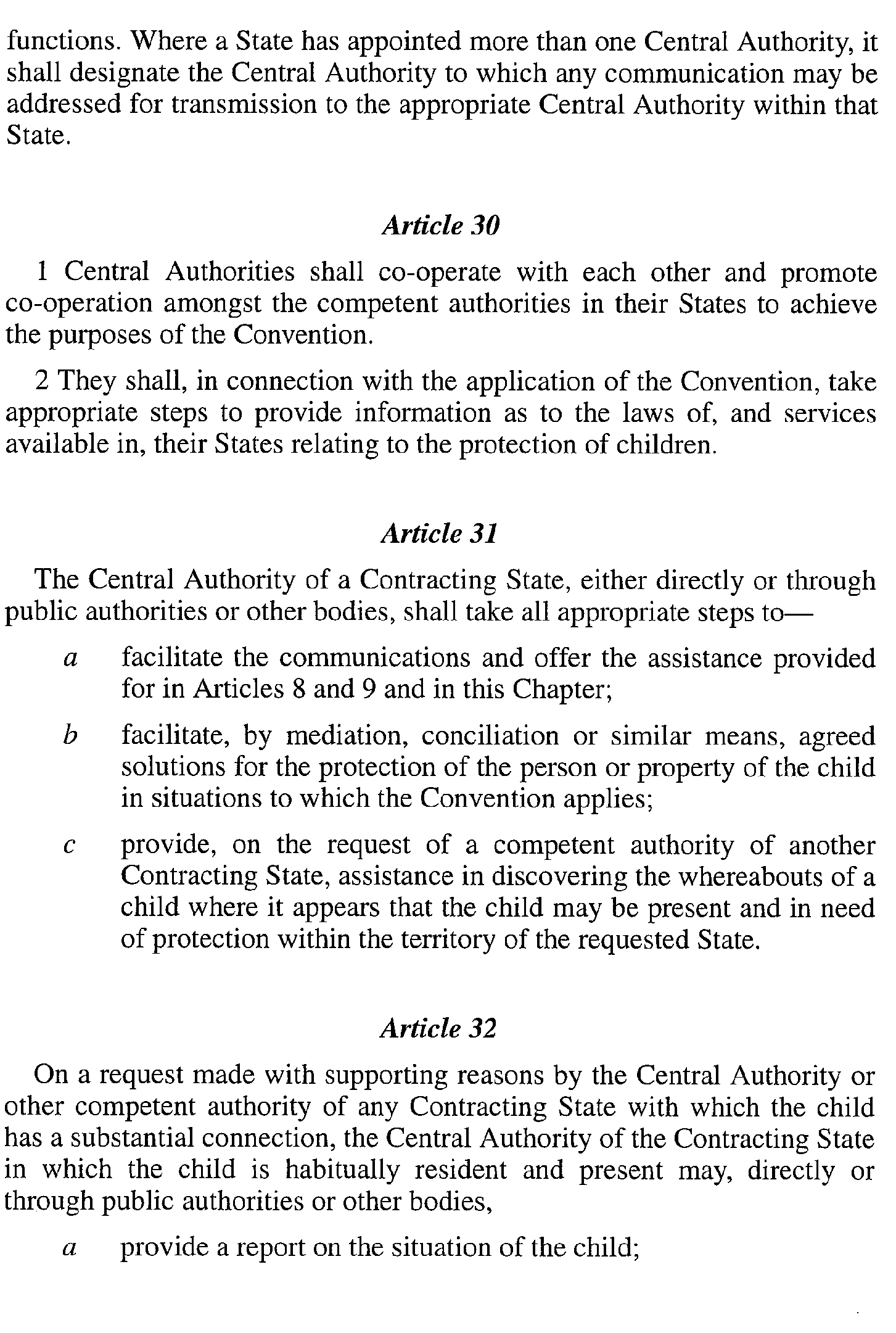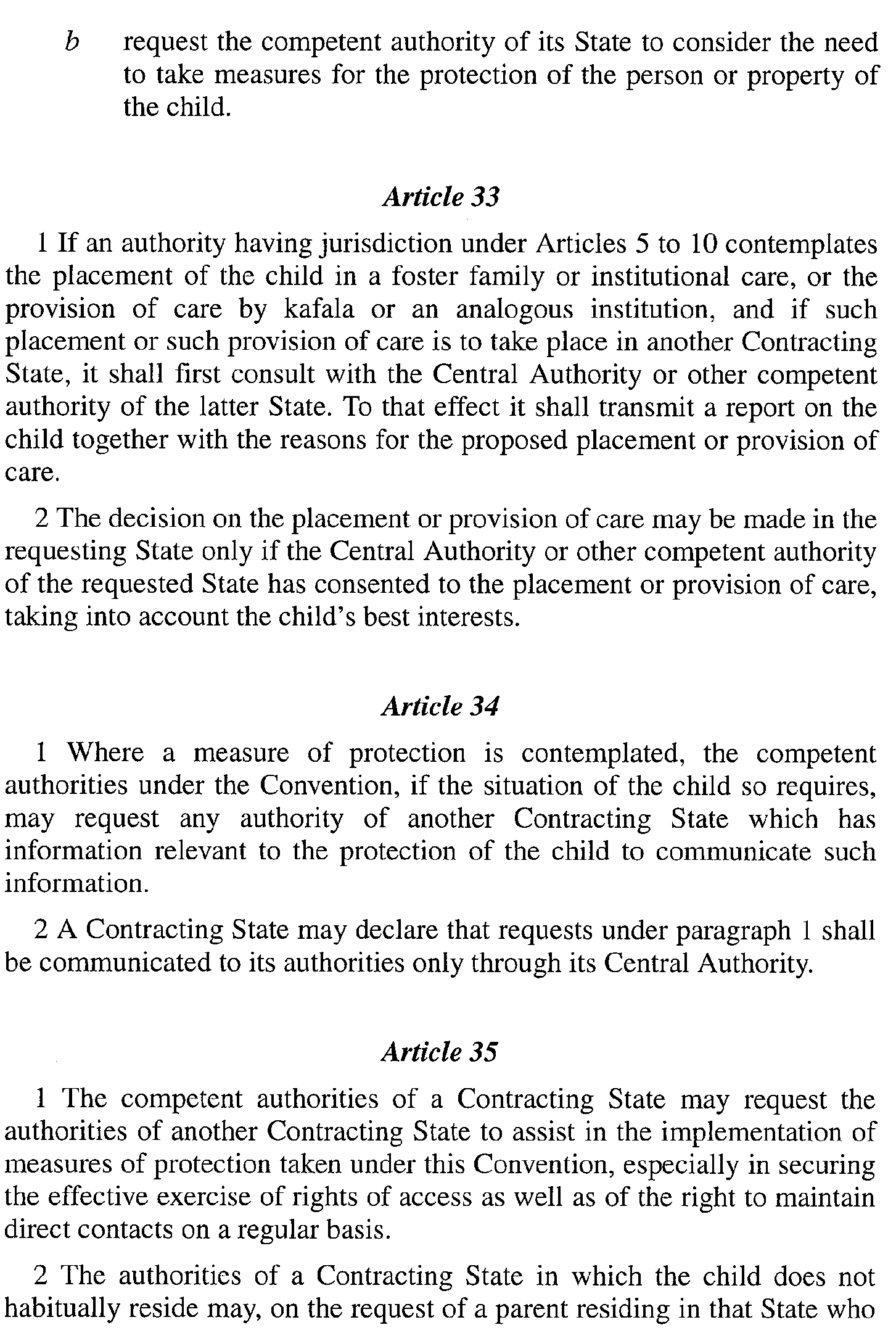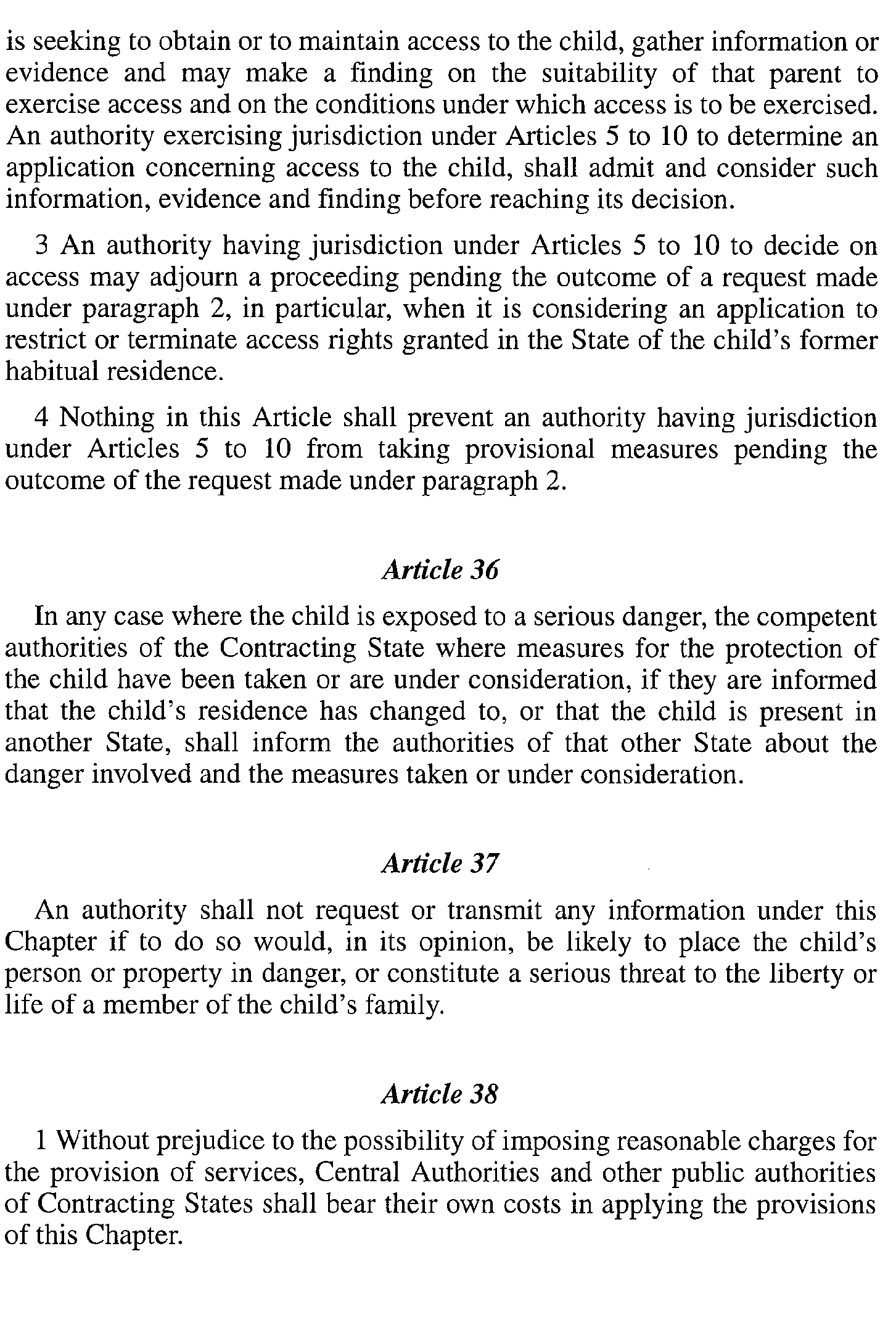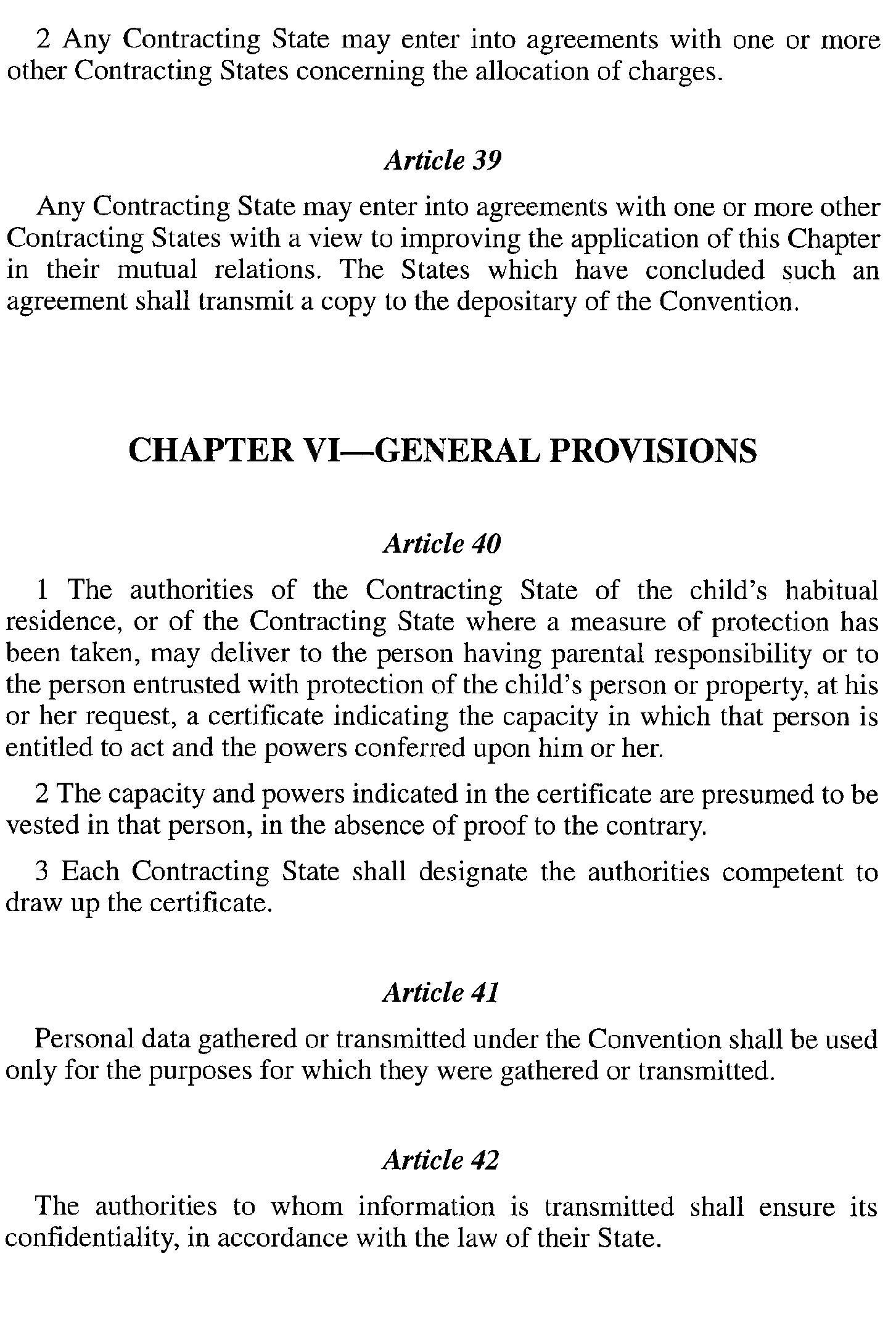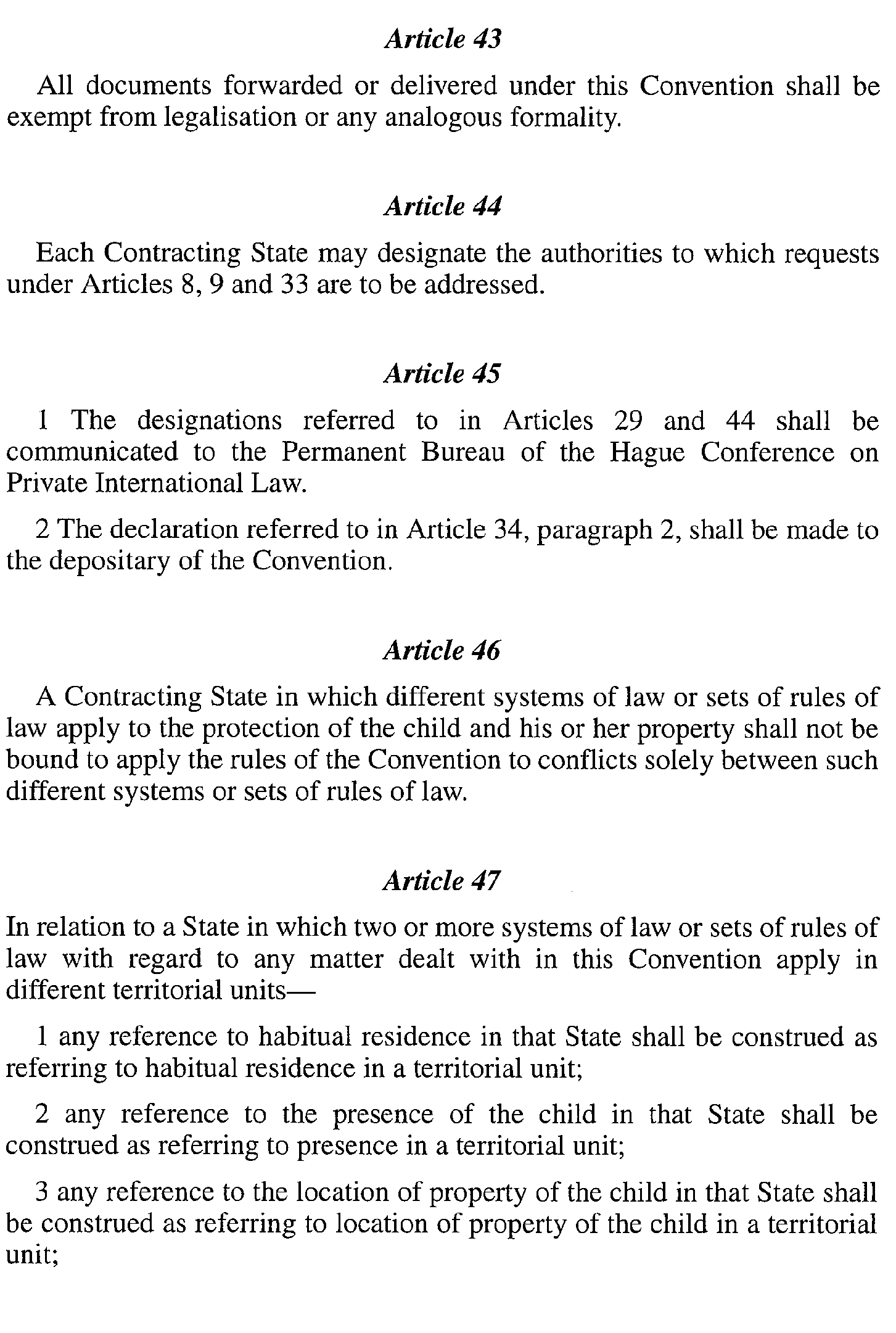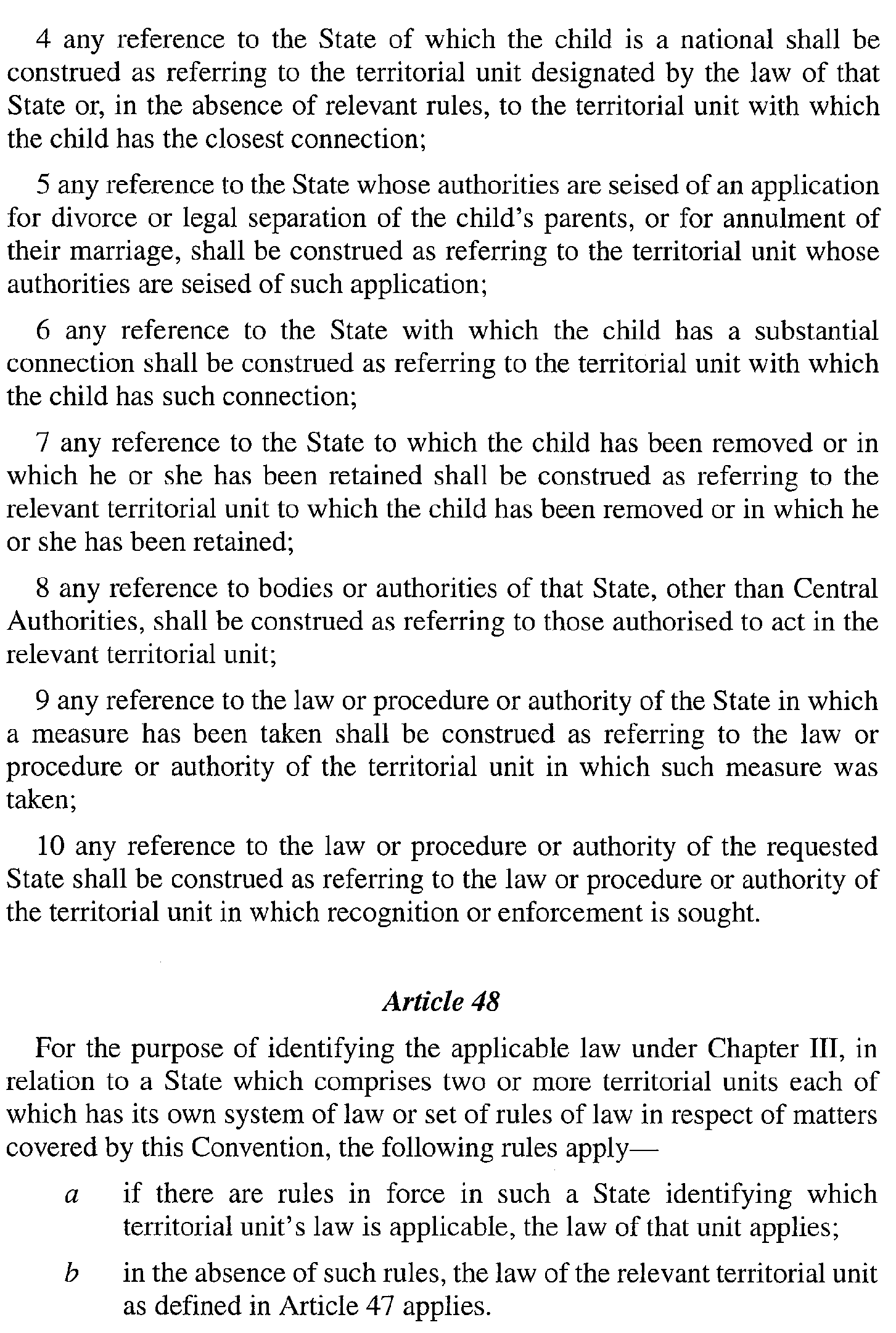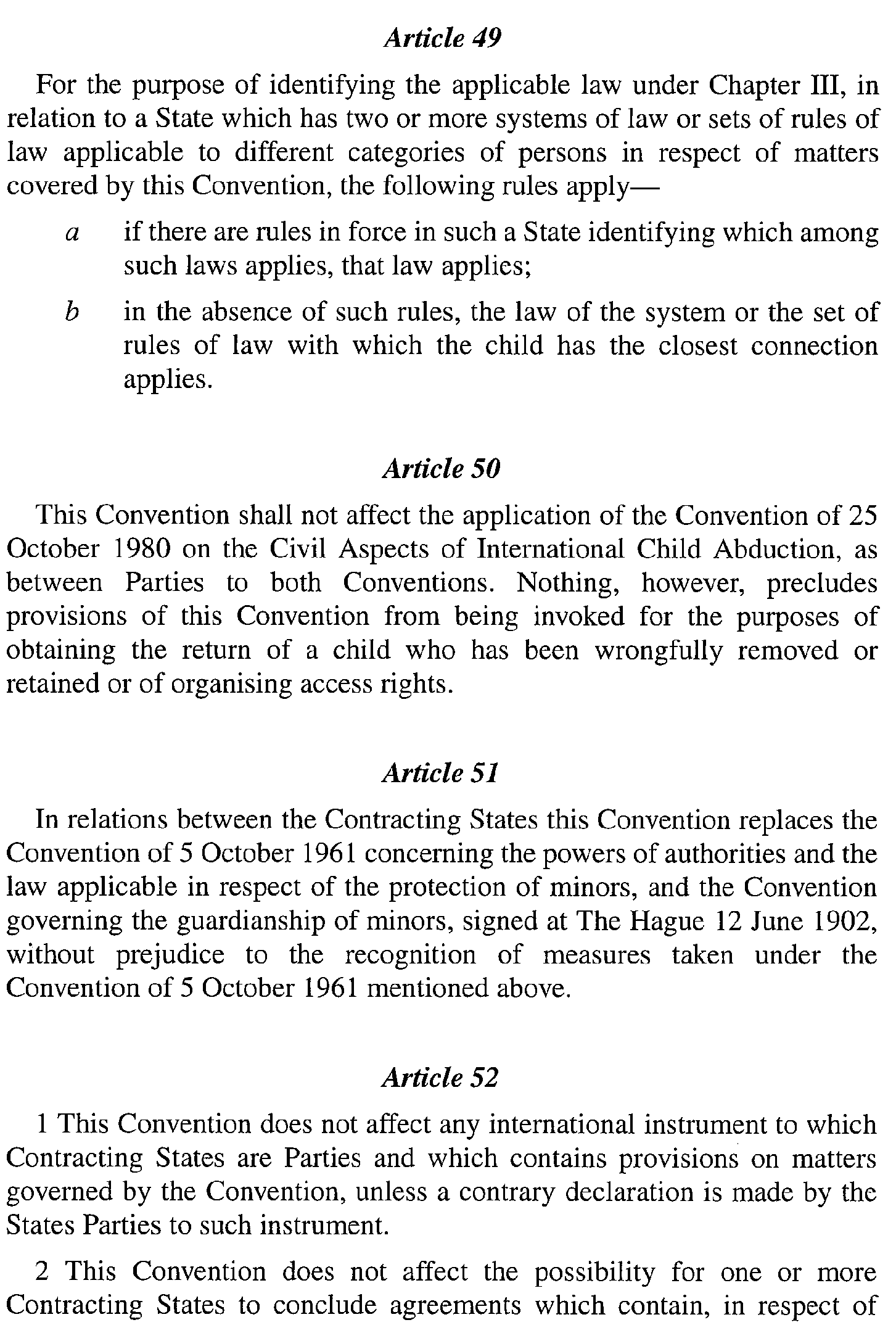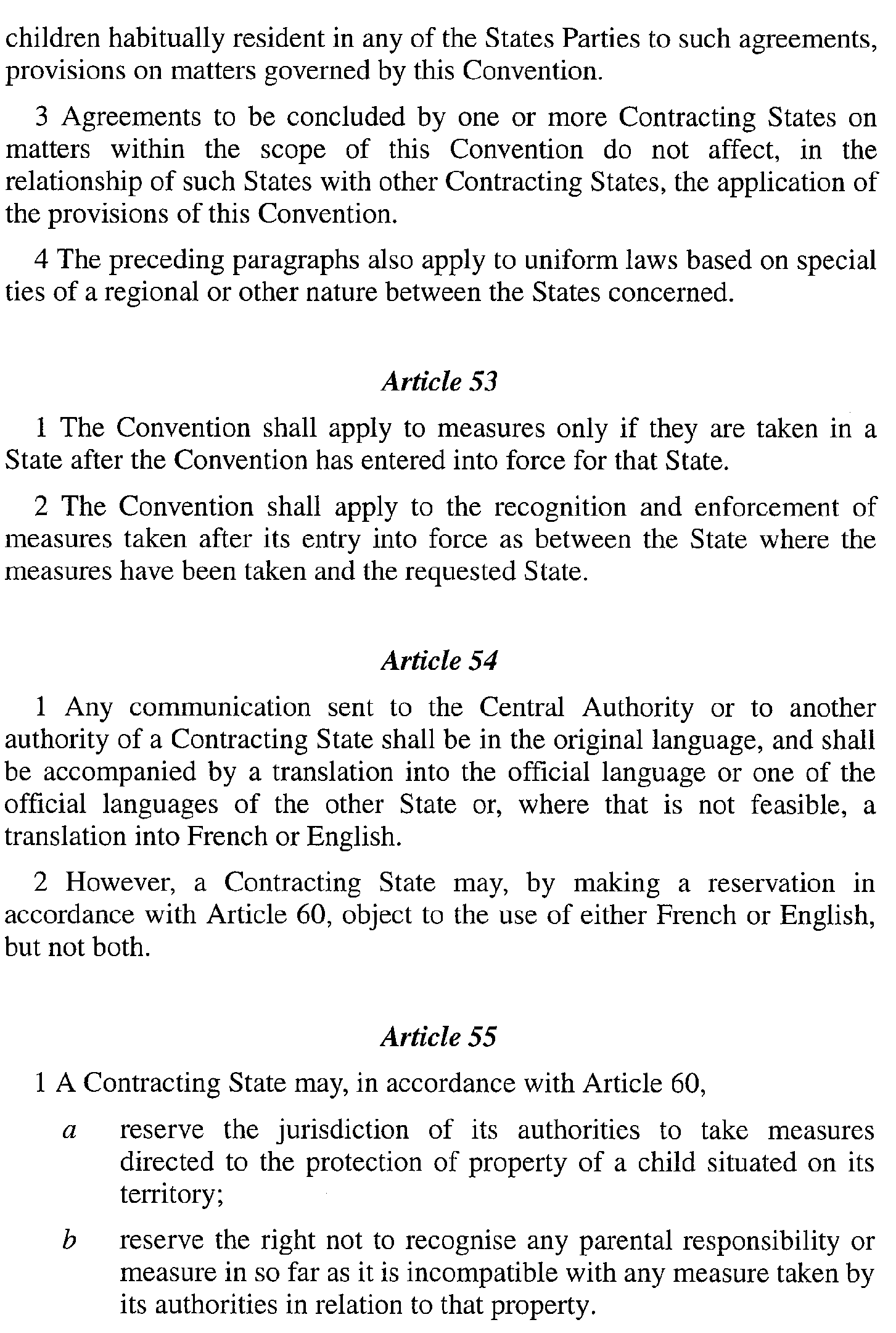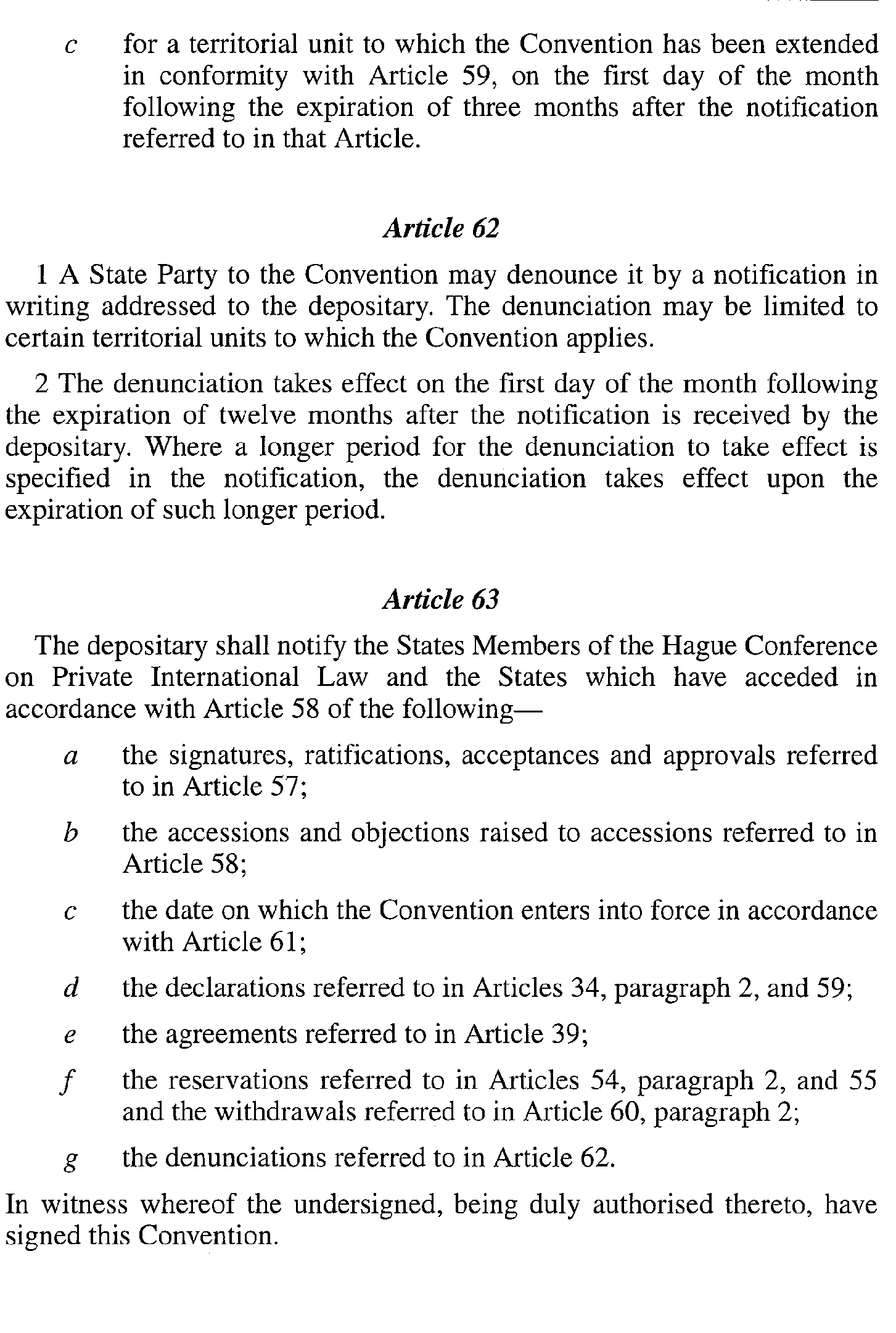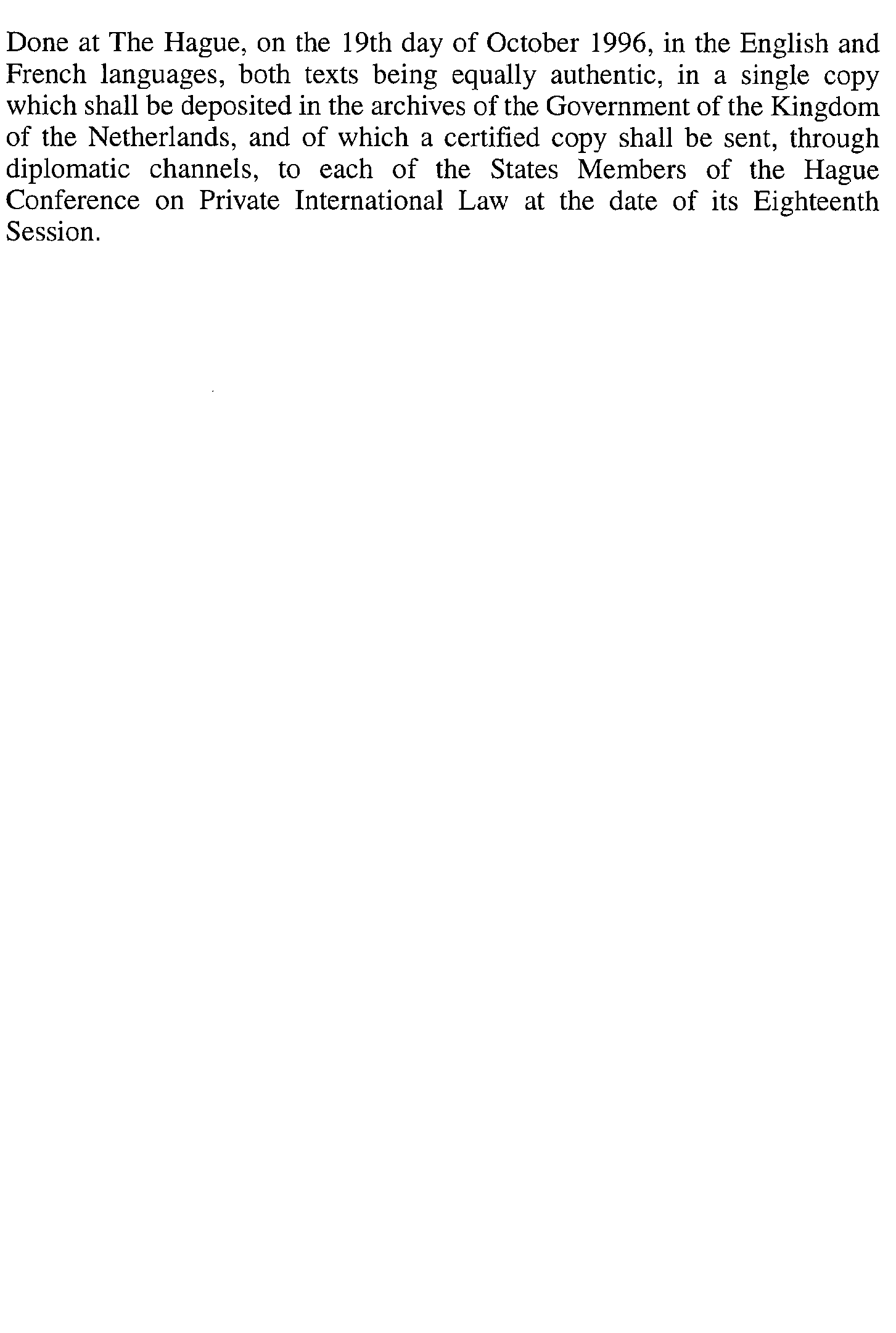An Act to provide for Queensland’s involvement in relation to the Convention on Jurisdiction, Applicable Law, Recognition, Enforcement and Co-operation in respect of Parental Responsibility and Measures for the Protection of Children, and for other purposes
This Act may be cited as the Child Protection (International Measures) Act 2003.
Schedule 3 commences on a day to be fixed by proclamation.
The main purposes of this Act are to recognise—(a)the importance of international co-operation for the protection of children; and(b)the need to avoid conflict between the legal systems of different countries about the jurisdiction, applicable law, recognition and enforcement of measures for the protection of children; and(c)that a child’s best interests are a primary consideration in relation to a measure for protecting the person of the child or a measure for protecting the child’s property.
(1)This Act does not apply to a matter to which the Child Protection Convention does not apply under Article 4 of the Convention.(2)This Act does not apply in relation to matters dealt with under an arrangement with New Zealand under the Child Protection Act 1999, chapter 7, parts 1 to 6.(3)To the extent that this Act and an arrangement referred to in subsection (2) are inconsistent in providing for the exercise of jurisdiction by a Queensland authority or a competent authority in a Convention country, this Act prevails.(4)In addition to measures to which the Child Protection Convention applies under Article 53, this Act applies to a measure taken in another country before the Convention has entered into force for that country if, at all relevant times that action is taken under this Act in relation to the measure, the Convention is in force for that country and Australia.
This Act binds all persons, including the State.
(1)The dictionary in schedule 4 defines particular words used in this Act.(2)Unless the contrary intention appears, expressions used—(a)in this Act; or(b)in regulations made for the purposes of this Act;have the same meaning as they have in the Child Protection Convention.
7Circumstances in which Queensland court may exercise jurisdiction
(1)If, under this Act, a Queensland court may exercise jurisdiction for a matter, the court may exercise the jurisdiction for the matter—(a)on application by the department, litigation director or public trustee; or(b)on its own initiative.(2)For this Act, department, litigation director and public trustee may make applications to a Queensland court.(3)Subsections (1) and (2) are not limited by, and do not limit, a provision made by or under this Act or another Act that states other persons may make an application under this Act or otherwise make a request to a Queensland court.As mentioned in section 16(2)(b)(iii), a Queensland authority may exercise jurisdiction in relation to a child habitually resident in a Convention country only if the Queensland authority is requested to assume the jurisdiction by, or at the invitation of, a competent authority of the country of the child’s habitual residence or country of refuge.s 7 amd 2016 No. 23 s 89
(1)This part applies only if an issue under Queensland law is whether a Queensland court, the department or the litigation director, as opposed to any of the following authorities, is to take measures directed to the protection of the person of a child—(a)a central authority or competent authority of a Convention country;(b)a competent authority of a non-Convention country.(2)This part does not apply if an issue under Queensland law is whether a Queensland court, the department or the litigation director, as opposed to another competent authority of Australia, is to take measures directed to the protection of the person of a child.s 8 amd 2016 No. 23 s 90
9Matters relating to jurisdiction for the person of a child
(1)This section applies if a Queensland authority has jurisdiction under Queensland law, apart from this Act, for a Queensland personal protection measure in relation to a child.(2)The Queensland authority may exercise jurisdiction for a Queensland personal protection measure only in relation to—(a)a child who is present and habitually resident in Australia; or(b)a child who is present in Australia and habitually resident in a Convention country, if—(i)the child’s protection requires taking the measure as a matter of urgency; or(ii)the measure is provisional and limited in its territorial effect to Australia; or(iii)the child is a refugee child; or(iv)a request to assume jurisdiction is made to a Queensland court or the department by a competent authority of the country of the child’s habitual residence; or(v)a competent authority of the country of the child’s habitual residence agrees to a Queensland court or the department assuming jurisdiction; or(c)a child who is present in a Convention country, if—(i)the child is habitually resident in Australia; or(ii)the child has been wrongfully removed from or retained outside Australia and Queensland authorities keep jurisdiction under Article 7 of the Child Protection Convention; or(iii)a request to assume jurisdiction is made to a Queensland court or the department by a competent authority of the country of the child’s habitual residence or country of refuge; or(iv)a competent authority of the country of the child’s habitual residence or country of refuge agrees to a Queensland court or the department assuming jurisdiction; or(d)a child who is present in Australia and is a refugee child; or(e)a child who is present in a non-Convention country, if—(i)the child is habitually resident in Australia; or(ii)the child is habitually resident in a non-Convention country and is an Australian citizen; or(f)a child who is present in Australia, if the child is habitually resident in a non-Convention country.(3)The Queensland authority may only exercise jurisdiction under subsection (2)(b)(ii) if the measure is not incompatible with a foreign measure already taken by a competent authority of a Convention country under Articles 5 to 10 of the Child Protection Convention.(4)Subsection (2)(a) to (d) is subject to the limitations in sections 10, 11 and 13.s 9 amd 2016 No. 23 s 91
10Limitation when a child is wrongfully removed from or retained outside a Convention country
A Queensland authority must not, other than in a case of urgency, exercise jurisdiction under section 9(2)(a), (b), (c) or (d) to take a Queensland personal protection measure relating to a child if—(a)the child has been wrongfully removed from or retained outside a Convention country; and(b)an authority of the Convention country keeps jurisdiction under Article 7 of the Child Protection Convention.
11Limitations concerning prior proceedings in a Convention country
(1)This section applies to the exercise of jurisdiction by a Queensland authority under section 9(2)(b)(iii) to (v) or (c).(2)If the Queensland authority is a Queensland court, before the court exercises the jurisdiction, it must order the department—(a)to use the department’s best efforts to consult with the competent authorities in the Convention country to find out whether measures relating to the protection of the person of the child have been sought from the competent authorities; and(b)to report to the court about the outcome of those efforts.(3)If the Queensland authority is the department, before the department exercises the jurisdiction, the department must use its best efforts to consult with the competent authorities in the Convention country—(a)to find out whether measures relating to the protection of the person of the child have been sought from the competent authorities; and(b)to decide the most appropriate course of action.(4)If the Queensland authority is the litigation director, before the director exercises the jurisdiction, the director must be satisfied the department has used its best efforts to consult with the competent authorities in the Convention country to find out whether measures relating to the protection of the person of the child have been sought from the competent authorities.s 11 amd 2016 No. 23 s 92
12If a Queensland authority is asked to assume jurisdiction
(1)A Queensland authority other than the litigation director may, if it considers that it is in the child’s best interests, accept or reject a request made under Article 8 of the Child Protection Convention by a competent authority of a Convention country for the Queensland authority to assume jurisdiction to take a Queensland personal protection measure relating to the child.(2)If the Queensland authority is a Queensland court, the court may order the department to do both of the following in a way that the department considers appropriate—(a)to request, under Article 9 of the Child Protection Convention, that a competent authority of a Convention country agree to the Queensland court assuming jurisdiction to take a Queensland personal protection measure relating to the child;(b)to report to the court about the outcome of the request.(3)The Queensland court may only make the order under subsection (2) if it considers that it is better placed than the competent authority to assess the child’s best interests.s 12 amd 2016 No. 23 s 93
13Limitation if a competent authority of Convention country is asked to assume jurisdiction
(1)A Queensland court may order the department to request, in a way the department considers appropriate, a competent authority described in Article 8, paragraph 2 of the Child Protection Convention—(a)to assume jurisdiction under Article 8 of the Convention for protecting the person of a child; and(b)as the competent authority considers necessary, to take measures to protect the person of a child; and(c)to report to the court about the outcome of the request.(2)In addition, the Queensland court may make any other order it considers necessary for an order under subsection (1).(3)The Queensland court may only make the order under subsection (1) if the court considers that the competent authority is better placed to assess the child’s best interests.(4)The Queensland court may accept or reject a request under Article 9 of the Child Protection Convention made by a competent authority of a Convention country described in Article 8, paragraph 2 of the Convention, for the competent authority to assume jurisdiction to take a measure for protecting the person of the child.(5)If the competent authority assumes jurisdiction under the request, a Queensland court must not exercise jurisdiction under section 9(2)(a), (b)(iii) to (v), (c) or (d), while the competent authority continues to exercise its jurisdiction.
14When a certain Queensland personal protection measure lapses
(1)A Queensland personal protection measure relating to a child that is taken in response to a particular situation by a Queensland authority exercising jurisdiction under section 9(2)(b)(i) or (ii) lapses if a foreign personal protection measure relating to the child, that is taken in response to the same situation, is recognised by registration under section 25.(2)A Queensland personal protection measure relating to a child that is taken in response to a particular situation by a Queensland authority exercising jurisdiction in a case of urgency, or in the taking of a measure of a provisional character, lapses if—(a)a measure for protecting the person of the child, that is taken in response to the same situation, is taken by a competent authority of a non-Convention country; and(b)the measure is recognised under Queensland law or under the law of another State.
(1)This part applies only if an issue under Queensland law is whether a Queensland court or the public trustee, as opposed to any of the following authorities, is to appoint, or determine the powers of, a guardian of a child’s property—(a)a central authority or competent authority of a Convention country;(b)a competent authority of a non-Convention country.(2)This part does not apply if an issue under Queensland law is whether a Queensland court or the public trustee, as opposed to another competent authority of Australia, is to appoint, or determine the powers of, a guardian of a child’s property.
16Matters relating to jurisdiction to appoint, or determine the powers of, a guardian of a child’s property
(1)This section applies if a Queensland authority has jurisdiction under Queensland law, apart from this Act, for a Queensland property protection measure in relation to a child.(2)The Queensland authority may exercise jurisdiction for a Queensland property protection measure only in relation to—(a)a child who is habitually resident in Australia; or(b)a child who is habitually resident in a Convention country, if—(i)the protection of the child’s property in Australia requires taking the measure as a matter of urgency; or(ii)the measure is provisional and limited in its territorial effect to property in Australia; or(iii)a request to assume jurisdiction is made to the Queensland authority by, or at the invitation of, a competent authority of the country of the child’s habitual residence or country of refuge; or(iv)a competent authority of the country of the child’s habitual residence or country of refuge agrees to the Queensland authority assuming jurisdiction; or(v)the child has been wrongfully removed from or retained outside Australia and Queensland authorities keep jurisdiction under Article 7 of the Child Protection Convention; or(c)a child who is present in Australia and is a refugee child; or(d)a child who is present in a non-Convention country, if—(i)the child is habitually resident in Australia; or(ii)the child is habitually resident in a non-Convention country and is an Australian citizen; or(e)a child who is present in Australia, if the child is habitually resident in a non-Convention country.(3)The Queensland authority may only exercise jurisdiction under subsection (2)(b)(ii) if the measure is not incompatible with a foreign measure already taken by a competent authority of a Convention country under Articles 5 to 10 of the Child Protection Convention.(4)Subsection (2)(a) to (c) is subject to the limitations in sections 17, 18 and 20.
17Limitation when a child is wrongfully removed from or retained outside a Convention country
A Queensland authority must not, other than in a case of urgency, exercise jurisdiction under section 16(2)(a), (b) or (c) to take a Queensland property protection measure relating to a child if—(a)the child has been wrongfully removed from or retained outside a Convention country; and(b)an authority of the Convention country keeps jurisdiction under Article 7 of the Child Protection Convention.
18Limitations when prior proceedings pending in a Convention country
(1)This section applies to the exercise of jurisdiction by a Queensland authority under section 16(2)(a), (b)(iii) to (v) or (c).(2)The Queensland authority must not exercise that jurisdiction to take a Queensland property protection measure relating to a child if—(a)a corresponding measure has been sought from a competent authority of a Convention country and it was sought—(i)if the Queensland authority is a Queensland court—before the proceedings were started in the court; or(ii)if the Queensland authority is the public trustee—before the public trustee exercises the jurisdiction; and(b)any of the following applies—(i)the child is habitually resident in the Convention country;(ii)the child is present in the Convention country and is a refugee child;(iii)a request to assume jurisdiction is made to a competent authority of the country of the child’s habitual residence or country of refuge;(iv)a competent authority of the country of the child’s habitual residence or country of refuge agrees to the competent authority assuming jurisdiction;(v)the competent authority of the Convention country is exercising jurisdiction in proceedings concerning the divorce or separation of the child’s parents or the annulment of their marriage (but see subsection (3));(vi)the child has been wrongfully removed from or retained outside the Convention country and a competent authority of the Convention country keeps jurisdiction under Article 7 of the Child Protection Convention.(3)Subsection (2)(b)(v) only applies (subject to subsection (4)) if—(a)one or both of the child’s parents are habitually resident in the Convention country when the proceedings referred to in that subparagraph are started; and(b)one or both of the parents have parental responsibility for the child; and(c)the jurisdiction of the competent authority of the Convention country to take the measure is accepted by the parents and each other person with parental responsibility for the child; and(d)the exercise of jurisdiction to take the measure is in the best interests of the child; and(e)the proceedings on the application for divorce or separation of the child’s parents or the annulment of their marriage have not been finalised.(4)Subsection (2) does not apply if the competent authority of the Convention country has declined jurisdiction or is no longer considering taking the measure sought.
19If Queensland authority is asked to assume jurisdiction
(1)A Queensland court may, if it considers that it is in the child’s best interests, accept or reject a request made under Article 8 of the Child Protection Convention by, or at the invitation of, a competent authority of a Convention country for the Queensland court to assume jurisdiction to take a Queensland property protection measure relating to the child.(2)A Queensland court may order, or invite the parties to proceedings before the court to ask, the department or the public trustee to do both of the following in a way that the department or the public trustee considers appropriate—(a)to request, under Article 9 of the Child Protection Convention, that a competent authority of a Convention country agree to the Queensland court assuming jurisdiction to take a Queensland property protection measure relating to the child;(b)to report to the court about the outcome of the request.(3)The public trustee must—(a)apply to a Queensland court, under the Public Trustee Act 1978, for an order that the public trustee may accept a request, under Article 9 of the Child Protection Convention, for the public trustee to assume jurisdiction to take a Queensland property protection measure relating to the child that the public trustee consider necessary; or(b)reject the request.(4)The Queensland court may only—(a)make the order, or issue the invitation, under subsection (2) if it considers that it is better placed than the competent authority to assess the child’s best interests; or(b)make the order under subsection (3)(a) if it considers that the public trustee is better placed than the competent authority to assess the child’s best interests.
20Limitation if a competent authority of a Convention country is asked to assume jurisdiction
(1)A Queensland court may order, or invite the parties to proceedings before the court to ask, the department or the public trustee to request, in a way the department or the public trustee considers appropriate, a competent authority described in Article 8, paragraph 2 of the Child Protection Convention—(a)to assume jurisdiction under Article 8 of the Convention for appointing, or deciding the powers of, a guardian of the child’s property; and(b)as the competent authority considers necessary, to take a measure appointing, or deciding the powers of, a guardian of the child’s property; and(c)to report to the court about the outcome of the request.(2)In addition, the Queensland court may make any other order it considers necessary for an order under subsection (1).(3)The Queensland court may only make the order or issue the invitation under subsection (1) if the court considers that the competent authority is better placed to assess the child’s best interests.(4)The Queensland court may accept or reject a request under Article 9 of the Child Protection Convention made by, or at the invitation of, a competent authority of a Convention country described in Article 8, paragraph 2 of the Convention, for the competent authority to assume jurisdiction to take measures for the protection of the child’s property.(5)If the competent authority assumes jurisdiction under the request, a Queensland court must not exercise jurisdiction under section 16(2)(a), (b)(iii) to (v) or (c) while the competent authority continues to exercise its jurisdiction.
21When a certain Queensland property protection measure lapses
(1)A Queensland property protection measure relating to a child that is taken in response to a particular situation by a Queensland authority exercising jurisdiction under section 16(2)(b)(i) or (ii) lapses if—(a)a foreign property protection measure relating to the child, that is taken in response to the same situation, is taken by a competent authority of a Convention country; and(b)any of the following applies—(i)the child is habitually resident in the Convention country;(ii)the child is present in the Convention country and is a refugee child;(iii)a request to assume jurisdiction is made to the competent authority of the Convention country by, or at the invitation of, a competent authority of the country of the child’s habitual residence;(iv)a competent authority of the country of the child’s habitual residence agrees to the competent authority of the Convention country assuming jurisdiction;(v)a competent authority of the Convention country is exercising jurisdiction in proceedings concerning the divorce or separation of the child’s parents or the annulment of their marriage (but see subsection (2));(vi)the child has been wrongfully removed from or retained outside the Convention country and a competent authority of the Convention country keeps jurisdiction under Article 7 of the Child Protection Convention.(2)Subsection (1)(b)(v) only applies if—(a)one or both of the child’s parents are habitually resident in the Convention country when the proceedings referred to in that subparagraph are started; and(b)one or both of the parents have parental responsibility for the child; and(c)the jurisdiction of the competent authority of the Convention country to take the measure is accepted by the parents and each other person with parental responsibility for the child; and(d)the exercise of jurisdiction to take the measure is in the best interests of the child; and(e)the proceedings on the application for divorce or separation of the child’s parents or the annulment of their marriage have not been finalised.(3)A Queensland property protection measure relating to a child that is taken in response to a particular situation by a Queensland authority exercising jurisdiction in a case of urgency, or in the taking of a measure of a provisional character, lapses if—(a)a measure for the appointment, or the determination of the powers, of a guardian for the child’s property, that is taken in response to the same situation, is taken by a competent authority of a non-Convention country; and(b)the measure is recognised under Queensland law or under the law of another State.
(1)This section applies to a Queensland authority exercising jurisdiction under part 2 or 3.(2)The Queensland authority must apply Queensland law in exercising that jurisdiction, other than choice of law rules.(3)However, the Queensland authority may in exceptional circumstances apply or take into account the law of another country with which—(a)a child has a substantial connection; or(b)a child’s property is substantially connected;if the Queensland authority considers the protection of the person of the child, or the child’s property, requires the authority to do so.
(4)In this section—law does not include choice of law rules.
23Action on receipt of foreign personal protection measure
(1)This section applies if the department is given either of the following documents, together with a request for the department to take an action under the Child Protection Convention—(a)a document that is a foreign personal protection measure relating to a child;(b)a document that, although it is not a foreign personal protection measure relating to a child, states details of a foreign personal protection measure relating to a child.(2)After consulting with the competent authority of the country in which the foreign personal protection measure was taken, the department must do one of the following—(a)give the foreign personal protection measure to a registrar of a Queensland court for recognition of the measure by registration under section 25;(b)give the foreign personal protection measure to the Commonwealth central authority together with a request for the Commonwealth central authority to take action under the Child Protection Convention, including, for example, registration of the foreign measure under the Family Law Act 1975 (Cwlth);(c)exercise the department’s jurisdiction under part 2;(d)refer the matter to the litigation director for the director to exercise the director’s jurisdiction under part 2;(e)apply to a Queensland court for the court—(i)to exercise the court’s jurisdiction under part 2; or(ii)to decide whether or not the court should refuse recognition of the foreign measure under subsection (3);(f)agree with the competent authority that the department will not do anything.(3)A Queensland court may order a foreign personal protection measure relating to a child be refused recognition on any of the following grounds—(a)the competent authority of the Convention country did not have jurisdiction under the Child Protection Convention for taking the foreign personal protection measure;(b)in taking the foreign personal protection measure, the competent authority of the Convention country is taken to have acted contrary to the fundamental principles of procedure under Queensland law as mentioned in subsection (4);(c)recognition of the foreign personal protection measure is contrary to public policy in Queensland having regard to the child’s best interests;(d)if the foreign personal protection measure were recognised by registration under section 25, there would be no appropriate means of enforcing the measure under Queensland law;(e)the foreign personal protection measure is incompatible with a later measure taken in a non-Convention country in which the child habitually resides and, if the later measure were a foreign personal protection measure, it could not be refused recognition under paragraph (b) or (c);(f)the foreign personal protection measure places the child in a foster family or institutional care in Queensland and the competent authority did not obtain the department’s consent to the placement before taking the measure.(4)A competent authority is taken to have acted contrary to the fundamental principles of procedure under Queensland law if—(a)the competent authority did not give the child, or a person with parental responsibility for the child, an opportunity to be heard before taking the foreign personal protection measure; and(b)the competent authority did not take the foreign personal protection measure as a matter of urgency.(5)A person who is interested in the following may apply to the court to be joined as a party to the proceeding—(a)an application to a Queensland court made by the litigation director following a referral by the department under subsection (2)(d);(b)an application to a Queensland court made by the department under subsection (2)(e).(6)If—(a)under subsection (2)(a) the department gives a foreign personal protection measure relating to a child to a registrar of a Queensland court; and(b)the measure authorises the performance of a medical procedure or treatment on the child that is a procedure or treatment for which a parent does not, under Queensland law, have authority to consent;the measure must be accompanied by a Family Court declaration that recognition of the measure is not contrary to public policy having regard to the child’s best interests.
(7)In this section—Family Court declaration means a declaration by a court exercising jurisdiction for proceedings under the Family Law Act 1975 (Cwlth) or the Family Court Act 1997 (WA).s 23 amd 2016 No. 23 s 94
24Action on receipt of foreign property protection measure
(1)This section applies if the department is given either of the following documents, together with a request for the department to take an action under the Child Protection Convention—(a)a document that is a foreign property protection measure relating to a child;(b)a document that, although it is not a foreign property protection measure relating to a child, states details of a foreign property protection measure relating to a child.(2)The department must consider whether the foreign property protection measure includes a provision directed to protecting the person of the child.(3)If the department considers the foreign property protection measure includes a provision directed to protecting the person of the child, the department must deal with the measure under section 23 as if it were a foreign personal protection measure.(4)If the department does not consider the foreign property protection measure includes a provision directed to protecting the person of the child, the department must give the measure to a registrar of a Queensland court for recognition of the measure by registration under section 25.
25Recognition of foreign measures in Queensland courts
(1)A registrar of a Queensland court must register a foreign measure given to the registrar by the department under section 23 or 24.(2)A foreign measure registered under subsection (1)—(a)has the same force and effect as a Queensland personal protection measure or a Queensland property protection measure (as appropriate); and(b)prevails over an earlier measure in force in Queensland to the extent the foreign measure is inconsistent with the earlier measure.(3)An interested person may take legal proceedings in a Queensland court to enforce a foreign measure registered under subsection (1).(4)Subsections (2) and (3) are subject to the cancellation of the registration of the foreign measure under section 26.
26Cancellation of registered foreign measure and related matters
(1)An interested person may apply to a Queensland court to cancel the registration under section 25 of a foreign measure relating to a child.(2)The Queensland court may cancel the registration of the foreign measure if any of the following applies—(a)for a foreign measure that is a foreign personal protection measure—the Queensland court may take a Queensland personal protection measure relating to the child under part 2;(b)for a foreign measure that is a foreign property protection measure—the Queensland court may take a Queensland property protection measure relating to the child under part 3;(c)the relevant competent authority responsible for taking the foreign measure did not have jurisdiction, under the Child Protection Convention, for taking the measure;(d)in taking the measure, the relevant competent authority is taken to have acted contrary to the fundamental principles of procedure under Queensland law as mentioned in subsection (3);(e)recognition or enforcement of the measure in Queensland is contrary to public policy taking into account the child’s best interests;(f)for a foreign measure that is a foreign property protection measure—there are no appropriate means of enforcing the measure under Queensland law.(3)The relevant competent authority is taken to have acted contrary to the fundamental principles of procedure under Queensland law if—(a)the competent authority did not give the child, or a person with parental responsibility for the child, an opportunity to be heard before taking the foreign measure; and(b)the competent authority did not take the foreign measure as a matter of urgency.
27Matters relevant for Queensland court in proceeding under s 23 or 26
(1)This section applies to a proceeding in a Queensland court under section 23 or 26 about a foreign measure.(2)The Queensland court is bound by findings of fact on which the competent authority of the Convention country based its jurisdiction.(3)Subject to section 26, the Queensland court must not review the merits of the measure.(4)A document of a competent authority of a Convention country is admissible as evidence of the facts stated in the document.(5)An affidavit of a witness who resides outside Australia, that is filed in the proceeding, is admissible as evidence in the proceeding, even though the witness does not attend for cross-examination in the proceeding.
28Recognition and enforcement of Queensland measure
(1)After consulting with the central authority or a competent authority of a Convention country, the department may give a Queensland personal protection measure relating to a child to the central authority of the Convention country for recognition and enforcement of the Queensland personal protection measure in the Convention country.(2)The department may give a Queensland property protection measure relating to a child to the central authority of a Convention country for recognition and enforcement of the Queensland property protection measure in the Convention country.
29Department is Queensland’s central authority
(1)For the Child Protection Convention, the department is Queensland’s central authority.(2)If the department must or may perform a function or exercise a power under this Act, including under any of the following, the chief executive is responsible for performing the function or exercising the power—(a)a Queensland measure;(b)a foreign measure recognised by registration under section 25;(c)an order of a Queensland court under this Act, other than a Queensland measure.
(1)The department’s functions include co-operating with central authorities of Convention countries—(a)to find solutions for the protection of particular children; and(b)to help in the implementation of Queensland measures, foreign measures and measures of non-Convention countries directed to protecting children or their property; and(c)to consider taking, applying for or referring to the litigation director to consider applying for, a Queensland measure relating to a child—(i)at the request of a competent authority of another country if the measure is a Queensland personal protection measure; or(ii)at the request, or at the invitation, of a competent authority of another country if the measure is a Queensland property protection measure; and(d)to exchange information, subject to appropriate confidentiality provisions; and(e)to provide information on laws and services; and(f)to help in locating children; and(g)to provide reports on the situation of particular children; and(h)to apply to Queensland courts for orders in response to requests from competent authorities in Convention countries—(i)to transfer or receive jurisdiction; or(ii)to take measures directed to protecting the person of a child or measures directed to protecting a child’s property.An application to a Queensland court for a measure that is a child protection order under the Child Protection Act 1999 may be made by the litigation director if a referral is made to the director under the Director of Child Protection Litigation Act 2016 following consideration by the department as mentioned in paragraph (c).(2)If a competent authority of a Convention country consults with the department for the purpose of obtaining the department’s consent to placing a child with a foster family, or in institutional care, in Queensland, the department must take into account the child’s best interests in deciding whether or not to consent.(3)Subsection (1) is subject to section 34(2).s 30 amd 2016 No. 23 s 95
31Obligation to obtain consent to place child
(1)A Queensland authority must obtain the consent of a competent authority of a Convention country before placing a child in a foster family, or in institutional care, in the Convention country.(2)If the Queensland authority is a Queensland court, before placing a child, the Queensland authority may order the department to consult a competent authority of the Convention country concerned.(3)If a Queensland court orders the department to consult, then the court must provide the department with a report on the child and the reasons for the proposed placement.
32Obligation to inform competent authority about serious danger to a child
(1)A Queensland authority must inform a competent authority of another country about any information the Queensland authority may have about any serious danger to a child—(a)whose residence has moved from Queensland to the other country; or(b)who is present in the other country.(2)Subsection (1) has effect despite any obligation of confidentiality imposed on the Queensland authority or a person by a Queensland law or anything else (including a contract or professional ethics).(3)A person is not liable in civil or criminal proceedings, and is not to be considered to have breached any professional ethics, in respect of the provision of information under subsection (1).(4)Evidence of the provision of information under subsection (1) is not admissible in any—(a)court (whether or not exercising jurisdiction under this Act); or(b)tribunal or other body concerned with professional ethics;except where that evidence is given by the person who provided the information.
(5)In this section—Queensland authority includes a person carrying out duties, performing functions or exercising powers as—(a)a member of the court personnel; or(b)a public service employee of the department or public trustee.
33Proceedings etc. for contact
(1)A Queensland court hearing proceedings concerning contact with a child must admit into evidence and consider the findings (if any) of a competent authority of a Convention country on the suitability of a parent to have contact with the child.(2)A Queensland court may adjourn the proceedings concerning contact with a child pending the outcome of a request by a parent of the child to a competent authority of a Convention country for a finding on the suitability of the parent to have contact with the child.(3)On the application of a parent who is an Australian resident seeking to obtain or keep contact with a child, a Queensland court may—(a)admit evidence; and(b)make a finding on the suitability of that parent to have contact with the child; and(c)specify conditions on which the contact is to be given.(4)In considering a matter concerning contact with a child, the department—(a)must consider evidence and the findings (if any) of a competent authority of a Convention country on the suitability of a parent to have contact with the child; and(b)may postpone considering the matter pending the outcome of a request by a parent to a competent authority of a Convention country for a finding on the suitability of the parent to have contact with the child.
34Giving information to central authorities and competent authorities in Convention countries
(1)This section applies to—(a)a court; and(b)the Commonwealth central authority; and(c)central authorities of Australia appointed as mentioned in Article 29, paragraph 2, of the Child Protection Convention; and(d)other competent authorities of Australia.(2)If it would be consistent with this Act or the Child Protection Convention to do so, a Queensland authority may give information to—(a)a court or an authority of Australia to which this section applies; or(b)a central authority or other competent authority of a Convention country.
35Helping person in relation to Queensland measure
(1)A person who is to exercise parental responsibilities under a Queensland measure may apply to a Queensland authority for information about the particular way in which the person may exercise the person’s responsibilities under the Queensland measure.(2)The Queensland authority may, by written notice, give information to the person about the powers conferred on the person as a parent under the Queensland measure.
36Helping person in relation to foreign measure
(1)An interested person who wants to ask a competent authority of another country to vary or cancel a foreign measure may apply to the department for help in sending the request to the authority.(2)The department may help the interested person in relation to sending the request.
37Delegation by chief executive
(1)The chief executive may delegate the chief executive’s powers to an appropriately qualified officer of the department.(2)In this section—appropriately qualified includes having the qualifications, experience or standing appropriate to the exercise of the power.a person’s classification level in the public servicechief executive’s powers means the powers the chief executive must or may exercise under section 29.
(1)The Governor in Council may make regulations under this Act.(2)Without limiting subsection (1), a regulation may prescribe—(a)that a particular measure, or a particular type of measure, recognised by registration under section 25 has effect as a particular type of Queensland measure, as mentioned in section 25(2)(a); and(b)the way the measure or the type of measure has effect as the particular type of Queensland measure, including the way it may be varied or otherwise dealt with under an Act applying to that particular type of Queensland measure.
schedule 4, definition Child Protection Convention
section 6(1)
another country means a Convention country or a non-Convention country.
Australia includes the external Territories.
central authority of a Convention country means—
(a)if there is one central authority of the Convention country under Article 29 of the Child Protection Convention—the Convention country’s central authority; or
(b)otherwise—the central authority designated, under Article 29 of the Child Protection Convention, as the Convention country’s central authority to which any communication may be addressed for transmission to the appropriate central authority of the Convention country.
child means an individual who is under 18 years.
Child Protection Convention means the Convention on Jurisdiction, Applicable Law, Recognition, Enforcement and Co-operation in respect of Parental Responsibility and Measures for the Protection of Children signed at The Hague on 19 October 1996, a copy of the English text of which is set out in schedule 1.
Childrens Court means the Childrens Court established under the Childrens Court Act 1992.
Children Services Tribunal ...
sch 4 def Children Services Tribunal ins 2003 No. 87 s 47(2)
om 2009 No. 24 s 28(1)
Commonwealth central authority has the meaning given by the Family Law Act 1975 (Cwlth), section 111CA(1).
Family Law Act 1975 (Cwlth), section 111CA(1)—Commonwealth central authority means the Secretary of the Attorney-General’s Department.
competent authority—
(a)in relation to Australia means an entity that has responsibility or authority under the law in force in Australia, or part of Australia, to take measures or make decisions about—(i)protecting the person of a child; or(ii)appointing or deciding the powers of a guardian of a child’s property; and
(b)in relation to a Convention country means an entity that has responsibility or authority under the law in force in the Convention country to take, or make decisions about, a foreign measure relating to a child; and
(c)in relation to a non-Convention country means an entity that has responsibility or authority under the law in force in the country to take measures or make decisions about—(i)protecting the person of a child; or(ii)appointing or deciding the powers of a guardian of a child’s property.
Convention country means a country, other than Australia, for which the Child Protection Convention has entered into force.
country of refuge of a child means a country in which the child is present as a refugee child.
entity includes the following—
(a)an individual;
(b)a corporation;
(c)an unincorporated body;
(d)a government authority or body;
(e)a court or tribunal.
external Territory has the meaning given by the Acts Interpretation Act 1901 (Cwlth), section 17.
Acts Interpretation Act 1901 (Cwlth), section 17—External Territory means a Territory, not being an internal Territory, for the government of which as a Territory provision is made by any Act.
foreign measure means—
(a)a foreign personal protection measure; or
(b)a foreign property protection measure.
foreign personal protection measure relating to a child means a measure (within the meaning of the Child Protection Convention) taken by a competent authority of a Convention country for protecting the person of the child.
foreign property protection measure relating to a child means a measure (within the meaning of the Child Protection Convention) taken by a competent authority of a Convention country for appointing, or deciding the powers of, a guardian of the child’s property.
Guardianship and Administration Tribunal ...
sch 4 def Guardianship and Administration Tribunal ins 2003 No. 87 s 47(2)
om 2009 No. 24 s 28(1)
litigation director means the Director of Child Protection Litigation under the Director of Child Protection Litigation Act 2016.
sch 4 def litigation director ins 2016 No. 23 s 96
non-Convention country means a country for which the Child Protection Convention has not entered into force.
parental responsibility has the same meaning as in the Child Protection Convention.
public trustee means the public trustee under the Public Trustee Act 1978.
Queensland authority means—
(a)for a Queensland personal protection measure relating to a child—(i)a Queensland court; or(ii)the department; or(iii)in the case of a Queensland personal protection measure for which the litigation director may perform a function or exercise a power under the Director of Child Protection Litigation Act 2016—the litigation director;
(b)for a Queensland property protection measure—a Queensland court or the public trustee.
sch 4 def Queensland authority sub 2016 No. 23 s 96(1)–(2)
Queensland court means—
(a)the Supreme Court; or
(b)the District Court; or
(c)the Childrens Court; or
(d)a Magistrates Court; or
(e)QCAT.
sch 4 def Queensland court amd 2003 No. 87 s 47(3); 2009 No. 24 s 28(2)
Queensland law means the law in force in Queensland.
Queensland measure means—
(a)a Queensland personal protection measure relating to a child; or
(b)a Queensland property protection measure relating to a child.
Queensland personal protection measure relating to a child means a measure (within the meaning of the Child Protection Convention) under Queensland law that is directed to the protection of the person of the child.
Examples of Queensland personal protection measures—
1an assessment order or child protection order, within the meaning of the Child Protection Act 19992taking of a child into the chief executive’s custody under the Child Protection Act 1999, section 183a declaration assuming custody or guardianship of a child under the Child Protection Act 19994an order protecting the person of a child made by the Supreme Court exercising its inherent jurisdiction for children, including authorising the performance of a medical procedure on, or treatment of, a child for which a parent does not have authority, under Queensland law, to consent
sch 4 def Queensland personal protection measure amd 2016 No. 23 s 96(3)
Queensland property protection measure relating to a child means a measure (within the meaning of the Child Protection Convention) under Queensland law for appointing, or deciding the powers of, a guardian of the child’s property.
refugee child means a child—
(a)who is a refugee; or
(b)who is internationally displaced due to disturbances occurring in his or her country of habitual residence; or
(c)whose country of habitual residence cannot be determined.
registrar, in relation to a Queensland court, means—
(a)if the Queensland court is the Supreme Court—a registrar of the Supreme Court; or
(b)if the Queensland court is the District Court—a registrar, within the meaning of the District Court of Queensland Act 1967, of the court; or
(c)if the Queensland court is the Childrens Court—the person who, under the Childrens Court Act 1992, section 27, holds the same office for the Childrens Court as a registrar of the District Court or the clerk of a Magistrates Court; or
(d)if the Queensland court is a Magistrates Court—the clerk of the court; or
(e)if the Queensland court is QCAT—the principal registrar of QCAT.
sch 4 def registrar sub 2003 No. 87 s 47(1)–(2)
sch 4 amd 2009 No. 24 s 28(3)





